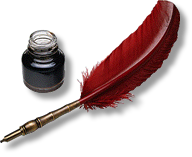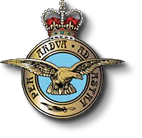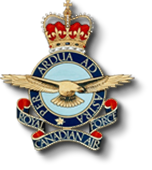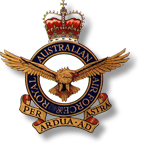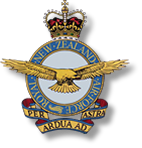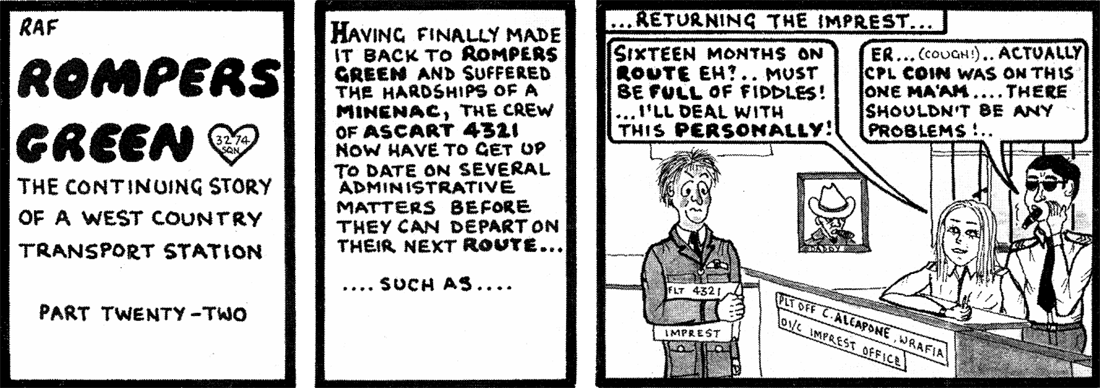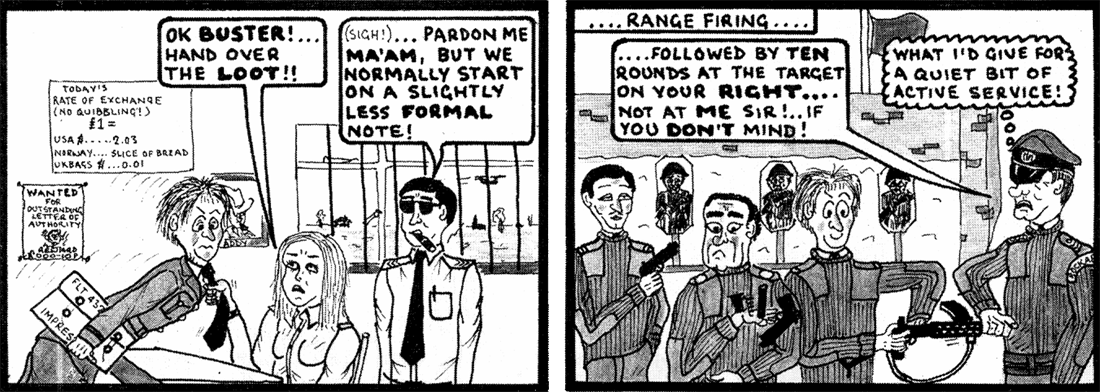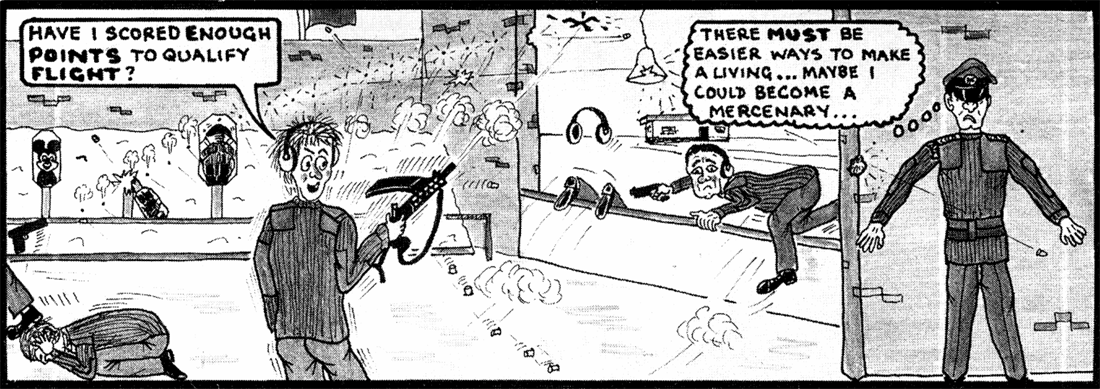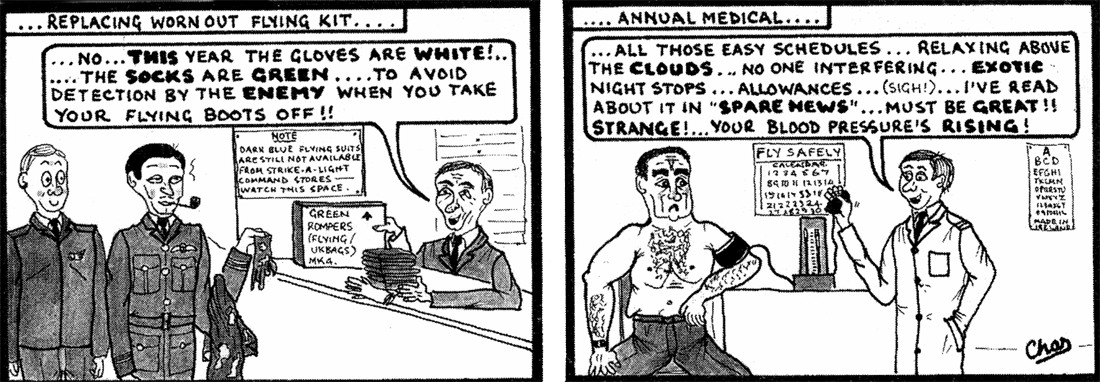

British aircraft fly over 676 trips to deliver Ukraine aid

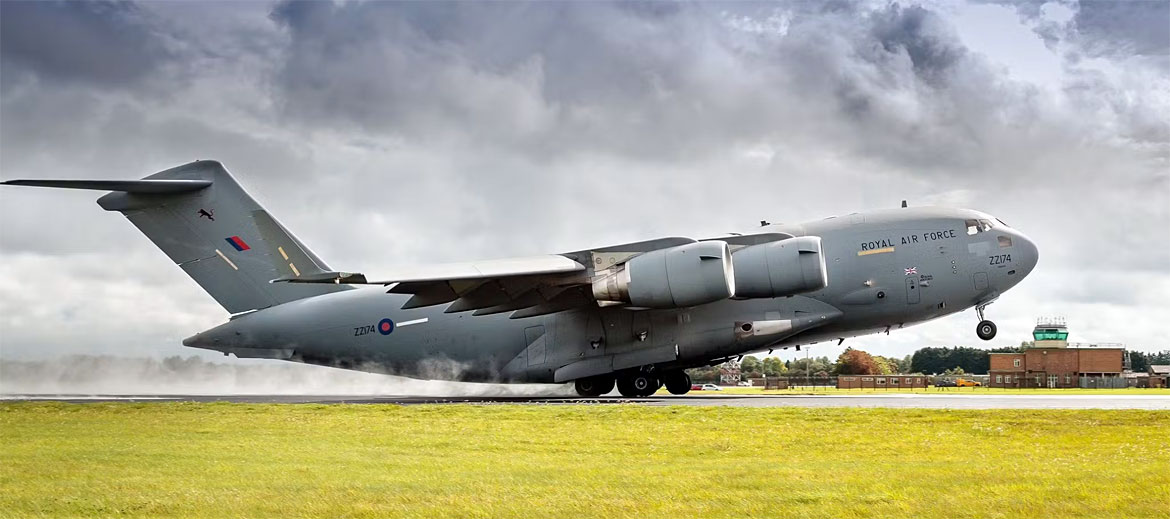
Between February 2022 and mid-July 2024, British transport aircraft conducted 676 flights to deliver military equipment to Ukraine, according to a recent National Audit Office (NAO) report.
The Royal Air Force (RAF) played a key role in these operations, flying crucial supplies to a drop-off point in Eastern Europe, from where they were handed over to the Armed Forces of Ukraine (AFU). This effort is part of the UK’s larger military support programme, which has committed £7.8 billion in aid to Ukraine since the onset of Russia’s invasion. The NAO report highlights the extensive logistical effort involved in providing equipment to Ukraine, including weapons, ammunition, and other essential military supplies. These deliveries were part of a broader effort to ensure that Ukrainian forces remain well-equipped to defend against Russian aggression.
Operation Interflex, the UK’s training programme for Ukrainian troops, also played a significant role in this support effort. The programme has successfully trained over 42,000 Ukrainian soldiers by July 2024, with 89% of participants from the latest tranche of recruits stating they felt better prepared for combat after completing the training.
However, the report also noted some challenges. The use of UK training sites for Ukrainian recruits has reduced availability for British Army units, which had their training bids rejected eight times more frequently in 2023 compared to 2019. Despite this, the Ministry of Defence (MoD) is working to mitigate the impact by collaborating with international partners and using Army Reserve resources to maintain UK training capacity.
The delivery of equipment to Ukraine has not only helped increase its defence capabilities but also placed pressure on UK military stockpiles. To address this, the MoD has invested nearly £1 billion to replenish donated equipment, with plans to spend £2.71 billion overall on replenishing and upgrading its stockpiles. This includes a £10 billion commitment to munitions production over the next decade.
ukdefencejournal.org.uk
The Royal Air Force (RAF) played a key role in these operations, flying crucial supplies to a drop-off point in Eastern Europe, from where they were handed over to the Armed Forces of Ukraine (AFU). This effort is part of the UK’s larger military support programme, which has committed £7.8 billion in aid to Ukraine since the onset of Russia’s invasion. The NAO report highlights the extensive logistical effort involved in providing equipment to Ukraine, including weapons, ammunition, and other essential military supplies. These deliveries were part of a broader effort to ensure that Ukrainian forces remain well-equipped to defend against Russian aggression.
Operation Interflex, the UK’s training programme for Ukrainian troops, also played a significant role in this support effort. The programme has successfully trained over 42,000 Ukrainian soldiers by July 2024, with 89% of participants from the latest tranche of recruits stating they felt better prepared for combat after completing the training.
However, the report also noted some challenges. The use of UK training sites for Ukrainian recruits has reduced availability for British Army units, which had their training bids rejected eight times more frequently in 2023 compared to 2019. Despite this, the Ministry of Defence (MoD) is working to mitigate the impact by collaborating with international partners and using Army Reserve resources to maintain UK training capacity.
The delivery of equipment to Ukraine has not only helped increase its defence capabilities but also placed pressure on UK military stockpiles. To address this, the MoD has invested nearly £1 billion to replenish donated equipment, with plans to spend £2.71 billion overall on replenishing and upgrading its stockpiles. This includes a £10 billion commitment to munitions production over the next decade.
ukdefencejournal.org.uk

From: Jacques Guay, Port Charlotte, FL
Subject: The worst aircraft to load
Hi Tony,
The worst aircraft to load? This is after I left the Air Force and started to work for Air Canada in Mirabel (CYMX) which had just opened some 60 km north of Montreal. An absolute pleasure of a place to work.
In my opinion it had to be the TU-144 [Concordeski] opened up the cargo holds, one person could not sit up at all. The biggest hold on that aircraft was at the front and took at least ten minutes for fill. The rest of the holds were tiny and just plain horrible to work. We all hated it with a passion. The aircraft was owned by Cubana. Do not know if they still have them, don't care either.
That's all folks.
Jacques
Subject: The worst aircraft to load
Hi Tony,
The worst aircraft to load? This is after I left the Air Force and started to work for Air Canada in Mirabel (CYMX) which had just opened some 60 km north of Montreal. An absolute pleasure of a place to work.
In my opinion it had to be the TU-144 [Concordeski] opened up the cargo holds, one person could not sit up at all. The biggest hold on that aircraft was at the front and took at least ten minutes for fill. The rest of the holds were tiny and just plain horrible to work. We all hated it with a passion. The aircraft was owned by Cubana. Do not know if they still have them, don't care either.
That's all folks.
Jacques


From: Bryan Morgan, Abingdon, Oxon
Subject: The worst aircraft to load
Tony,
From my experience the two most difficult aircraft to load both had side loading freight doors, i.e the Hastings and then the Britannia. Of these the former was challenging as it had a 20 degree upward sloping floor to contend with.
However, if you take loads into consideration, the Britannia had it's problems, especially if you were dealing with 8 Whirlwind rotor blades, each contained in a 25 foot or so sea freight container and weighing the best part of a ton each. I well remember the frustration at RAF Changi, when the off going shift, whose leader shall be nameless, would proudly boast that they had unloaded the Britannia in four hours leaving us just two hours to back load the beast with the previously mentioned rotor blades. I, together with the three other shifts, always worked on the principle that any turn round should take one third of the time available to complete the off load leaving two thirds for the back loading. I am sad to report that, in the 18 months I was the DAMO before becoming the Cargo Officer, I never got the culprit shift to see my point of view!
Regards,
Bryan
Subject: The worst aircraft to load
Tony,
From my experience the two most difficult aircraft to load both had side loading freight doors, i.e the Hastings and then the Britannia. Of these the former was challenging as it had a 20 degree upward sloping floor to contend with.
However, if you take loads into consideration, the Britannia had it's problems, especially if you were dealing with 8 Whirlwind rotor blades, each contained in a 25 foot or so sea freight container and weighing the best part of a ton each. I well remember the frustration at RAF Changi, when the off going shift, whose leader shall be nameless, would proudly boast that they had unloaded the Britannia in four hours leaving us just two hours to back load the beast with the previously mentioned rotor blades. I, together with the three other shifts, always worked on the principle that any turn round should take one third of the time available to complete the off load leaving two thirds for the back loading. I am sad to report that, in the 18 months I was the DAMO before becoming the Cargo Officer, I never got the culprit shift to see my point of view!
Regards,
Bryan
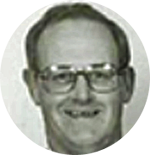
RAF marks 84th anniversary of Battle of Britain
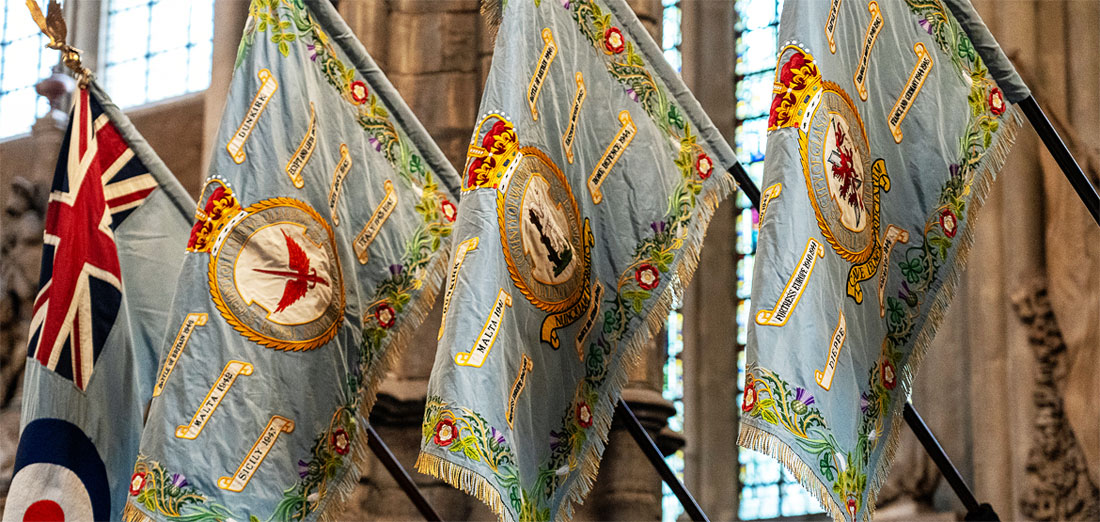
A Service of Thanksgiving and Rededication was held today to mark the 84th anniversary of the Battle of Britain, one of the most crucial battles of World War II.
The battle was the first decisive battle in history fought entirely in the air, lasting over three months, finally coming to an end on the 31st October. The service has taken place annually on the 15th September, the date chosen as Battle of Britain Day, since appointed by His Majesty King George VI back in 1943. The day recognises the momentous point in the fighting, when the Luftwaffe launched its heaviest bombing raids on London. Fighter Command responded to the attacks with success, resulting in heavy Luftwaffe losses.
The battle was the first decisive battle in history fought entirely in the air, lasting over three months, finally coming to an end on the 31st October. The service has taken place annually on the 15th September, the date chosen as Battle of Britain Day, since appointed by His Majesty King George VI back in 1943. The day recognises the momentous point in the fighting, when the Luftwaffe launched its heaviest bombing raids on London. Fighter Command responded to the attacks with success, resulting in heavy Luftwaffe losses.
Before the service started wreaths were laid at the RAF Memorial by serving personnel from New Zealand, Canada, Australia, South Africa and representatives from The Royal Air Force Association and the RAF Benevolent Fund.
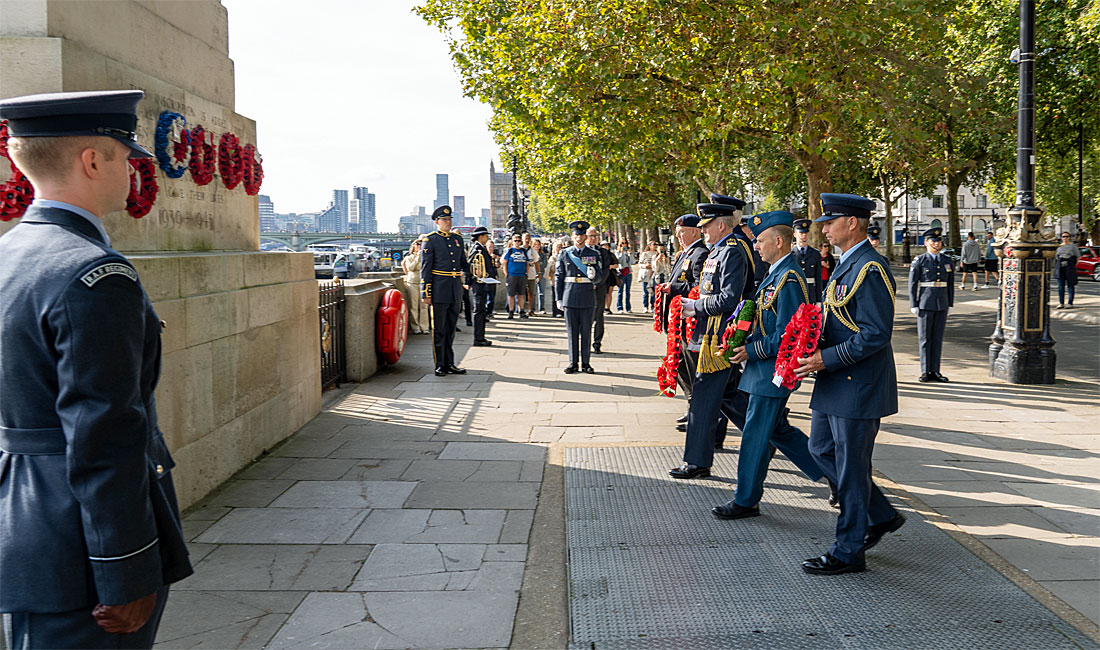
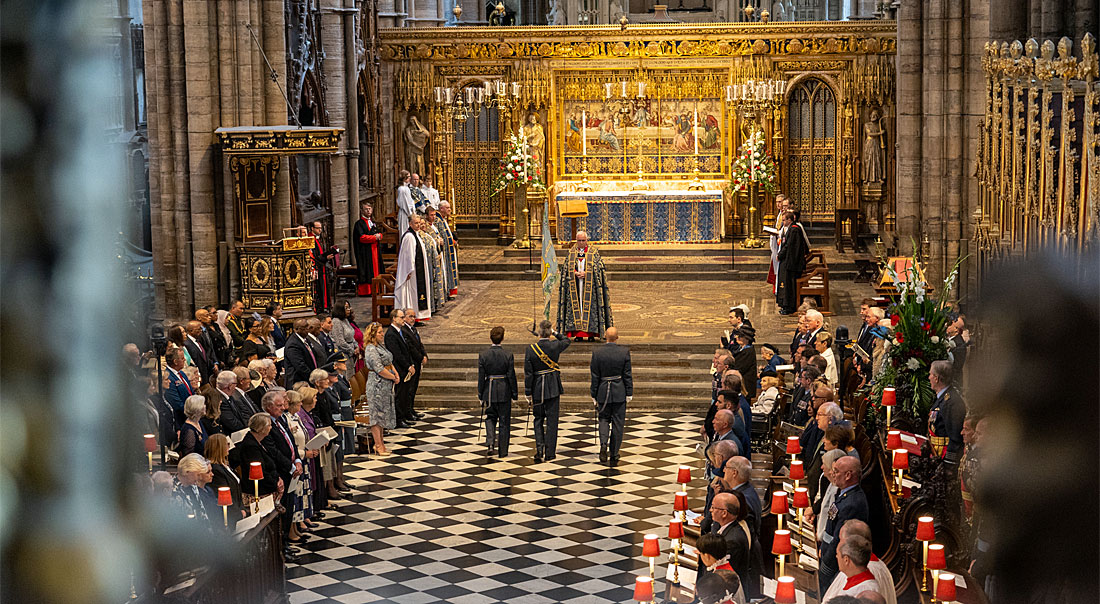
The service took place at Westminster Abbey, which has been the location for the commemoration since 1944. The battle continues to be commemorated over eighty years on to honour the hard work and determination of “the many” and the courage and sacrifice of “the few.”
“In this Abbey church, where our nation so often gathers to remember, to celebrate and to mourn, we give thanks for the dedication and daring of members of the Royal Air Force and Allied Air Forces during the Battle of Britain. Their sure courage halted the advance of a terrible tyranny. They held fast in days of greatest danger. For their resilience and their skill we give thanks, for their pain and loss we grieve. Once again, we commit ourselves to the duty of an honest remembrance.”
The Very Reverend Dr David Hoyle, Dean of Westminster
“In this Abbey church, where our nation so often gathers to remember, to celebrate and to mourn, we give thanks for the dedication and daring of members of the Royal Air Force and Allied Air Forces during the Battle of Britain. Their sure courage halted the advance of a terrible tyranny. They held fast in days of greatest danger. For their resilience and their skill we give thanks, for their pain and loss we grieve. Once again, we commit ourselves to the duty of an honest remembrance.”
The Very Reverend Dr David Hoyle, Dean of Westminster
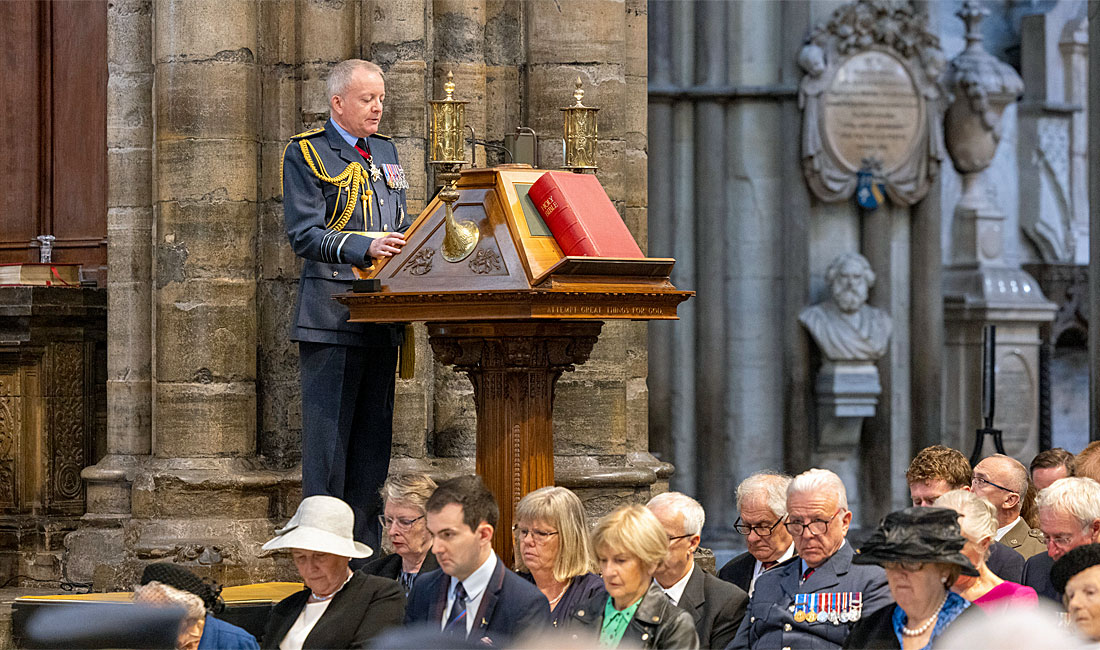
Speaking from the lectern at the altar, Air Chief Marshal, Sir Richard Knighton, Chief of the Air Staff, read the second Reading from 1 Corinthians 12: 4-11.

From: Stephen Davey, Tadcaster, North Yorks
Subject: The worst aircraft to load
Tony,
You must have read my mind as I agree with your sentiments regarding loading the Comet 4C. One afternoon whilst on traffic shift at Brize Norton, a Comet was diverted from Lyneham into Brize and our team were tasked with unloading and loading the aircraft - what joy, an experience never to be forgotten, limited space, knee breaking ridges in the belly hold, thankfully that was the only time we had to do it.
To be honest I didn't enjoy working in the Britannia belly hold either as space there was limited and the floors were pretty unforgiving and if you remember the forward hold could get very warm when you were loading with baggage or freight where the electrical equipment was situated and alternately the holds could be bloody freezing when you first went in to unload an aircraft which had only just landed, being tall was a distinct disadvantage and that's why we would prefer the short arse's going into the holds.
All the best, Steve
Subject: The worst aircraft to load
Tony,
You must have read my mind as I agree with your sentiments regarding loading the Comet 4C. One afternoon whilst on traffic shift at Brize Norton, a Comet was diverted from Lyneham into Brize and our team were tasked with unloading and loading the aircraft - what joy, an experience never to be forgotten, limited space, knee breaking ridges in the belly hold, thankfully that was the only time we had to do it.
To be honest I didn't enjoy working in the Britannia belly hold either as space there was limited and the floors were pretty unforgiving and if you remember the forward hold could get very warm when you were loading with baggage or freight where the electrical equipment was situated and alternately the holds could be bloody freezing when you first went in to unload an aircraft which had only just landed, being tall was a distinct disadvantage and that's why we would prefer the short arse's going into the holds.
All the best, Steve


From: Mick Craner, Yeovil, Somerset
Subject: The worst aircraft to load
Hello Tony,
I am sure that some older members would vote for the Hastings as it was all uphill. Many times on 48 Sqn Changi, I flew with loads that were a wonderful construction of chains, nets and not to forget the lashing tape (some of it the forbidden 1 inch!).
I once helped to load a Landrover and trailer at Gong Kedah in Malaysia. Members who have done that will know the amount of effort required. So, my vote for the worst aircraft to load is for the Hastings.
For me the best would be the Hercules; it should still be in RAF service.
Cheers
Mick Craner
Subject: The worst aircraft to load
Hello Tony,
I am sure that some older members would vote for the Hastings as it was all uphill. Many times on 48 Sqn Changi, I flew with loads that were a wonderful construction of chains, nets and not to forget the lashing tape (some of it the forbidden 1 inch!).
I once helped to load a Landrover and trailer at Gong Kedah in Malaysia. Members who have done that will know the amount of effort required. So, my vote for the worst aircraft to load is for the Hastings.
For me the best would be the Hercules; it should still be in RAF service.
Cheers
Mick Craner
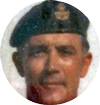

Seven hundred troops sent to Cyprus ready to evacuate Britons from Lebanon
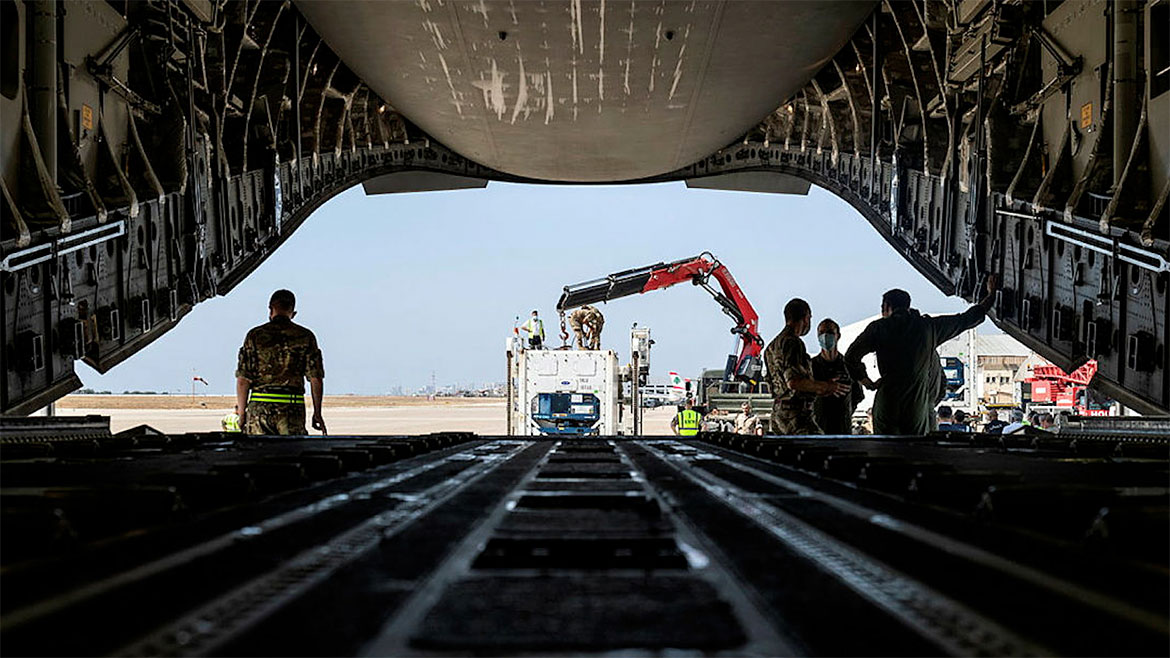
Around 700 British troops are being sent to Cyprus in case an emergency evacuation of Lebanon is required as fighting between Israel and Hezbollah continues to escalate. Royal Air Force aircraft and transport helicopters are also on standby and HMS Duncan and RFA Mounts Bay remain stationed in the eastern Mediterranean. The deployment of the troops to Cyprus, where the UK has a large military presence, comes as the Government begins the first stage of its contingency plan. The military team is being supported by Border Force and Foreign Office officials.
The deployment was announced after Defence Secretary John Healey held a Cobra meeting attended by intelligence chief and diplomats. He said British nationals should leave Lebanon now - and praised the military personnel deploying to the region. "Events in the past hours and days have demonstrated how volatile this situation is, which is why our message is clear: British nationals should leave now. We continue to urge all sides to step back from conflict to prevent further tragic loss of life. Our Government is ensuring all preparations are in place to support British nationals should the situation deteriorate. "I want to thank the British personnel who are deploying in the region for their commitment and professionalism."
Airlines are suspending flights to Lebanon because of the escalating violence, meaning commercial escape routes could be cut off as the situation deteriorates.
Sir Keir Starmer called on Israel and Hezbollah to "pull back from the brink" and urged Britons to board commercial flights out of Lebanon as soon as possible. Speaking to reporters whilst flying to New York for a United Nations summit, the Prime Minister said: "The most important message from me this evening is to British nationals in Lebanon, to leave immediately and I just want to reinforce that. Yes, we are ramping up the contingency plans, I think that you would expect that in light of the escalation. But it is important that we be really, really clear: now is the time to leave. More broadly, I am worried about the situation and I think we need to be clear we need de-escalation, we need a ceasefire, we need to pull back from the brink."
forcesnews.com
The deployment was announced after Defence Secretary John Healey held a Cobra meeting attended by intelligence chief and diplomats. He said British nationals should leave Lebanon now - and praised the military personnel deploying to the region. "Events in the past hours and days have demonstrated how volatile this situation is, which is why our message is clear: British nationals should leave now. We continue to urge all sides to step back from conflict to prevent further tragic loss of life. Our Government is ensuring all preparations are in place to support British nationals should the situation deteriorate. "I want to thank the British personnel who are deploying in the region for their commitment and professionalism."
Airlines are suspending flights to Lebanon because of the escalating violence, meaning commercial escape routes could be cut off as the situation deteriorates.
Sir Keir Starmer called on Israel and Hezbollah to "pull back from the brink" and urged Britons to board commercial flights out of Lebanon as soon as possible. Speaking to reporters whilst flying to New York for a United Nations summit, the Prime Minister said: "The most important message from me this evening is to British nationals in Lebanon, to leave immediately and I just want to reinforce that. Yes, we are ramping up the contingency plans, I think that you would expect that in light of the escalation. But it is important that we be really, really clear: now is the time to leave. More broadly, I am worried about the situation and I think we need to be clear we need de-escalation, we need a ceasefire, we need to pull back from the brink."
forcesnews.com
From: Don Lloyd, Calgary, AB
Subject: The worst aircraft to load
Hi Tony,
For the short time they were still around Namao, after I was stationed there, I think the Fairchild C-119 Flying Boxcar was by far the most difficult aircraft I ever loaded in my career. It started with 10ft. sections of skate wheel rollers, loose on the floor which were awkward and heavy. On top of that, most of the time, we put 40 X 48 inch pallets, or "Paul Bunyan's". Tie-down was mostly with rope and chains used to hold them together around the bottom of the pallet or around the middle of the metal containers. Heavy objects were moved around using a "dead man pry bar". The worst loads were the J-79 engine tank on skids on the rollers, it was all very labour intensive.
Thankfully along came the B-model Hercules and the advent of the dual rail roller system.
Cheers for now,
Don
Subject: The worst aircraft to load
Hi Tony,
For the short time they were still around Namao, after I was stationed there, I think the Fairchild C-119 Flying Boxcar was by far the most difficult aircraft I ever loaded in my career. It started with 10ft. sections of skate wheel rollers, loose on the floor which were awkward and heavy. On top of that, most of the time, we put 40 X 48 inch pallets, or "Paul Bunyan's". Tie-down was mostly with rope and chains used to hold them together around the bottom of the pallet or around the middle of the metal containers. Heavy objects were moved around using a "dead man pry bar". The worst loads were the J-79 engine tank on skids on the rollers, it was all very labour intensive.
Thankfully along came the B-model Hercules and the advent of the dual rail roller system.
Cheers for now,
Don



From: Ian Berry, Eastleaze, Swindon, Wilts
Subject: The worst aircraft to load
Hi Tony,
After much thought, I have to agree that the Comet was a real pain to load! Not only was the baggage hatch directly underneath the fuselage it wasn't that big and you could stand on the pan with your upper body inside. Fitting baggage through this was an utter pain. Large bags had to be juggled to fit and if they were heavy I'm sure they were the cause of many a permanent backache in later life. if the cargo net inside, adjacent to the hatch, had not been fitted correctly, baggage would sometimes move or fall onto the hatch in flight and so trying to open the hatch on arrival was another nightmare (just like the VC10 vent door, it opened inwards). As you mentioned, the cargo hold floor consisted of corrugated stringers and was absolute agony to kneel on, also hindering the passing of baggage. If the aircraft was full it was guaranteed you would 'bulk out' and have to use the 'Diplomatic Wardrobe' upstairs.
I seem to recall that there was at least one aerial protruding downwards underneath the aircraft and we all cracked our heads on it at least once! Whilst serving at RAF El Adem (Libya) I will never forget, that on one occasion, we discovered that the Lyneham Movers had loaded some 4 ton truck tyres in the lower hold. They were too wide to pull out and so two guys had to sit inside the hold and push against the tyre together to make it exit, once outside it sprang back to full width and bounced away... a vision I can still see to this day. Yes, a dreadful aircraft to load and unload.
Subject: The worst aircraft to load
Hi Tony,
After much thought, I have to agree that the Comet was a real pain to load! Not only was the baggage hatch directly underneath the fuselage it wasn't that big and you could stand on the pan with your upper body inside. Fitting baggage through this was an utter pain. Large bags had to be juggled to fit and if they were heavy I'm sure they were the cause of many a permanent backache in later life. if the cargo net inside, adjacent to the hatch, had not been fitted correctly, baggage would sometimes move or fall onto the hatch in flight and so trying to open the hatch on arrival was another nightmare (just like the VC10 vent door, it opened inwards). As you mentioned, the cargo hold floor consisted of corrugated stringers and was absolute agony to kneel on, also hindering the passing of baggage. If the aircraft was full it was guaranteed you would 'bulk out' and have to use the 'Diplomatic Wardrobe' upstairs.
I seem to recall that there was at least one aerial protruding downwards underneath the aircraft and we all cracked our heads on it at least once! Whilst serving at RAF El Adem (Libya) I will never forget, that on one occasion, we discovered that the Lyneham Movers had loaded some 4 ton truck tyres in the lower hold. They were too wide to pull out and so two guys had to sit inside the hold and push against the tyre together to make it exit, once outside it sprang back to full width and bounced away... a vision I can still see to this day. Yes, a dreadful aircraft to load and unload.
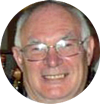
These are a couple of quotes I found online:
Wikipedia: Operationally, the design of the cargo holds led to considerable difficulty for the ground crew, especially baggage handlers at the airports. The cargo hold had its doors located directly underneath the aircraft, so each item of baggage or cargo had to be loaded vertically upward from the top of the baggage truck, then slid along the hold floor to be stacked inside. The individual pieces of luggage and cargo also had to be retrieved in a similarly slow manner at the arriving airport.
The Frustrations of the Comet 4 by Don Ford: The Comet may have been a superb flying machine but for the poor duty officer trying to cram passengers, baggage, mail and freight into its tiny interior, it could be highly frustrating. Most captains were helpful, although we can all remember some who weren’t! When we could not get all the baggage into the holds on the Comet, which was often, we could always put a couple of bags behind the back row in the first class. One captain, whose name I remember to this day, said he wasn’t having that, so I told him the bags would have stay to behind. He could not have cared less until I told him the two bags I had left over were his and the first officer’s!
Wikipedia: Operationally, the design of the cargo holds led to considerable difficulty for the ground crew, especially baggage handlers at the airports. The cargo hold had its doors located directly underneath the aircraft, so each item of baggage or cargo had to be loaded vertically upward from the top of the baggage truck, then slid along the hold floor to be stacked inside. The individual pieces of luggage and cargo also had to be retrieved in a similarly slow manner at the arriving airport.
The Frustrations of the Comet 4 by Don Ford: The Comet may have been a superb flying machine but for the poor duty officer trying to cram passengers, baggage, mail and freight into its tiny interior, it could be highly frustrating. Most captains were helpful, although we can all remember some who weren’t! When we could not get all the baggage into the holds on the Comet, which was often, we could always put a couple of bags behind the back row in the first class. One captain, whose name I remember to this day, said he wasn’t having that, so I told him the bags would have stay to behind. He could not have cared less until I told him the two bags I had left over were his and the first officer’s!
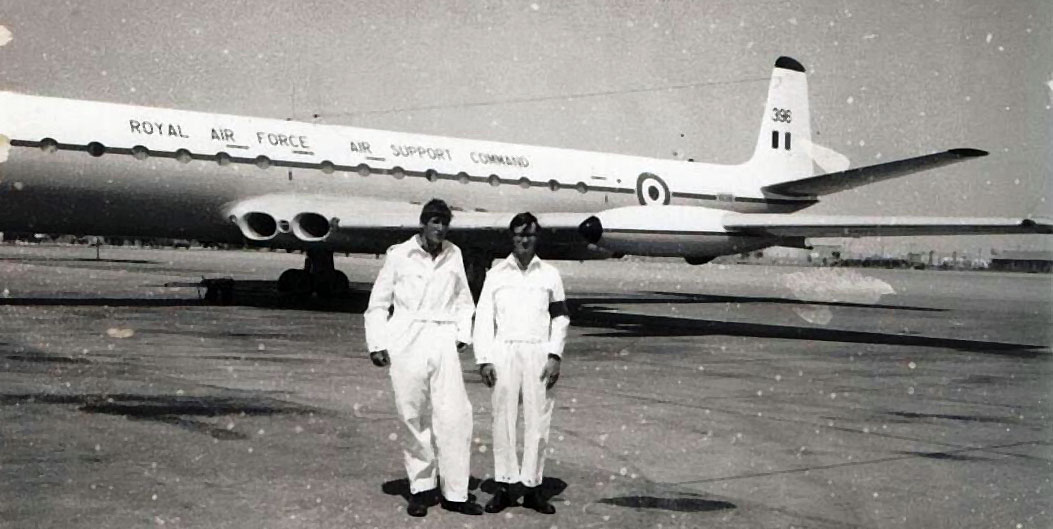
Keith Sharp and Myself at El Adem in 1969 doing VIP Duties on the Duke of Edinburgh's Comet
Ian
Red Arrows' Atlas bathes in Northern Lights as team head home from Canada
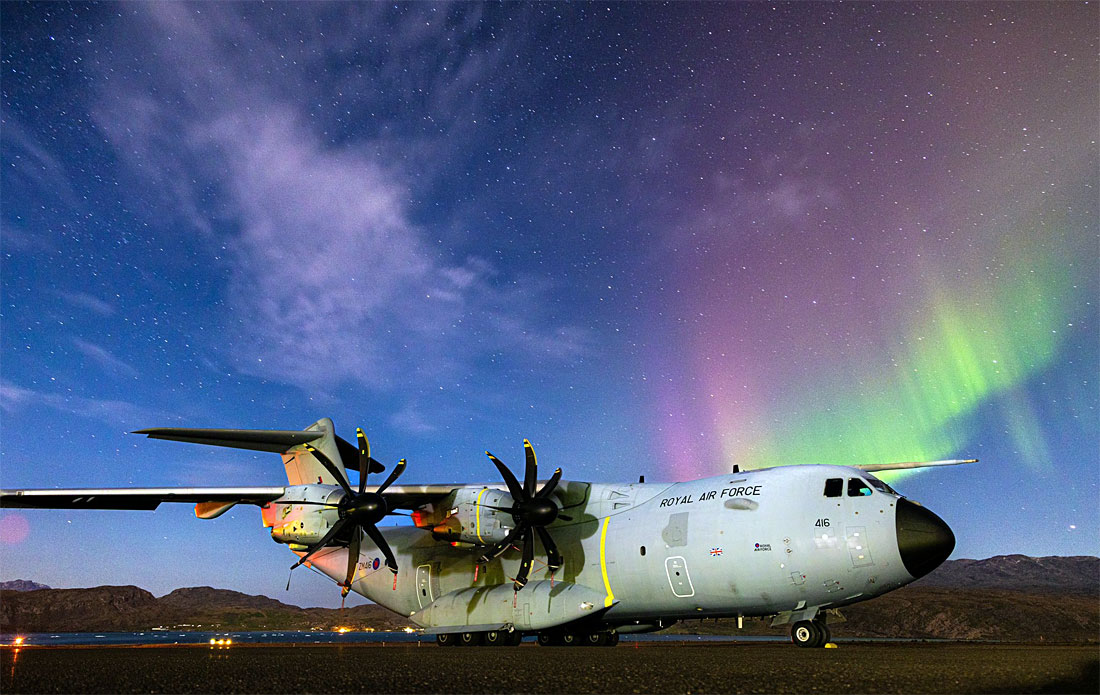
The Red Arrows and their Atlas support aircraft stopped in Iceland on their way home
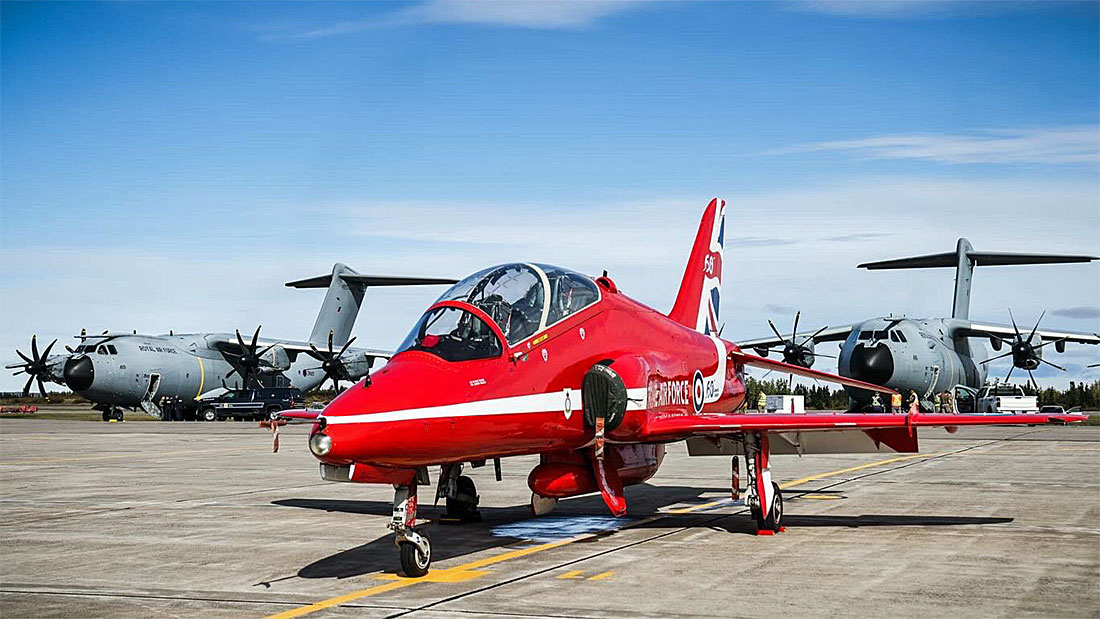
The Red Arrows and their Hawks were supported by Atlas A400M 's during their Maple Hawk display tour
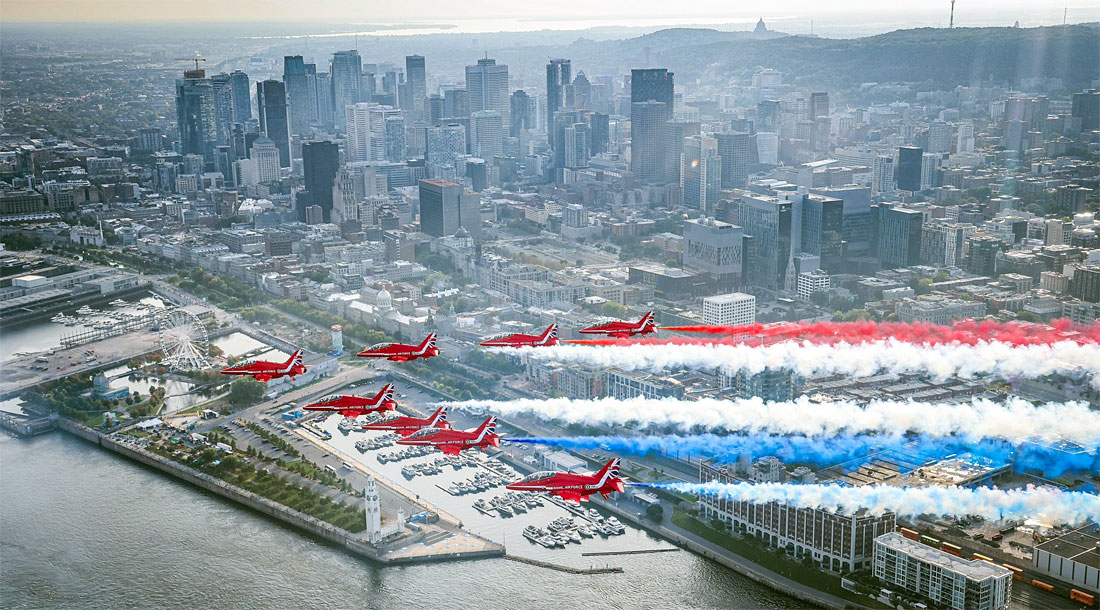
The team put on a display over Montreal
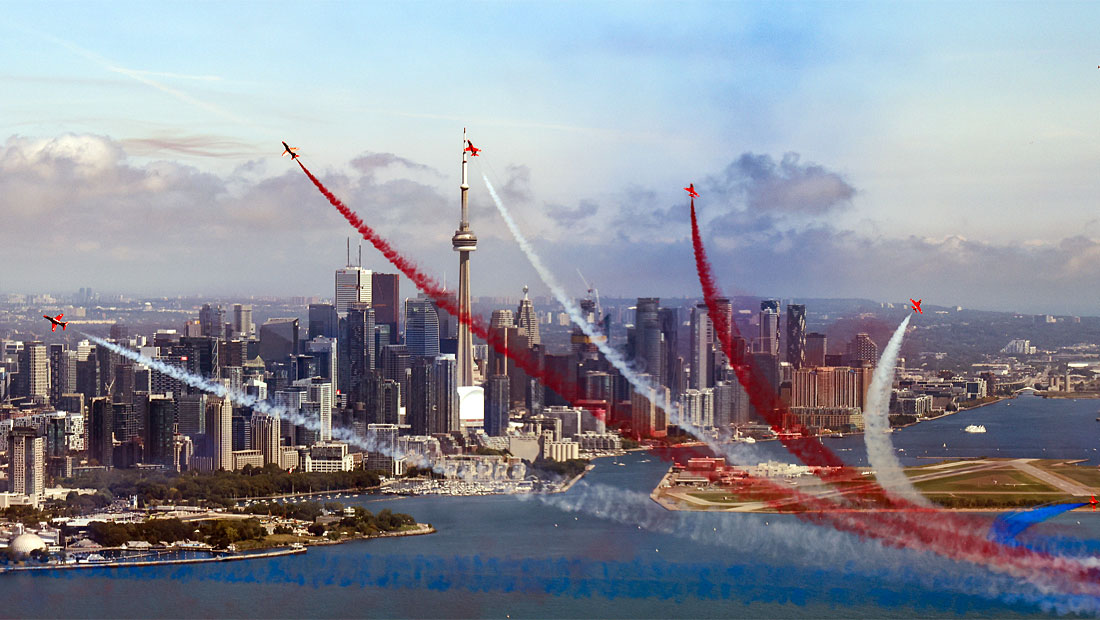
The Red Arrows put on a performance in front of the Canadian National Exhibition in Toronto
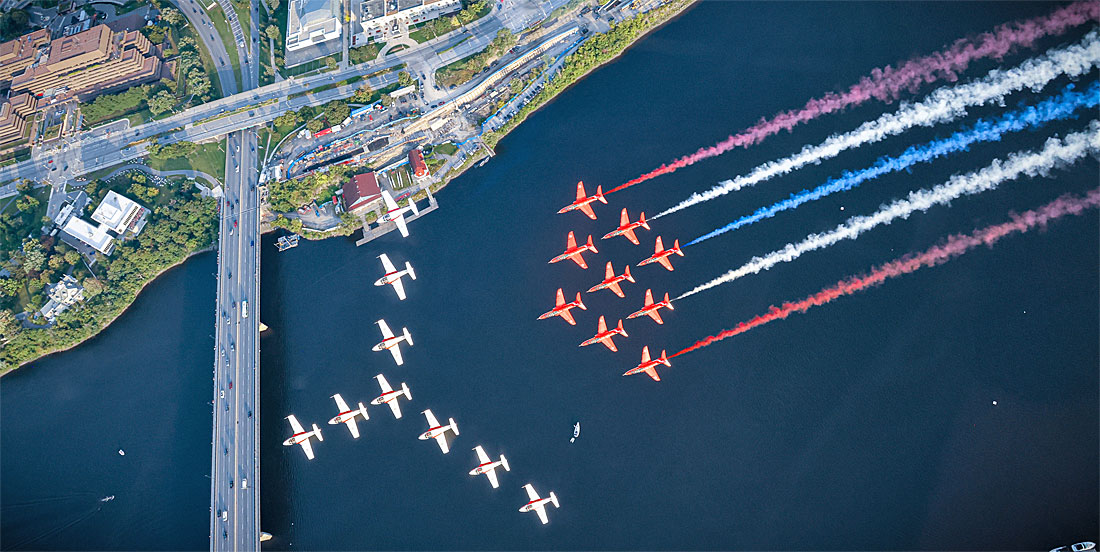
The Red Arrows with the Canadian Forces' Snowbirds over Ottawa
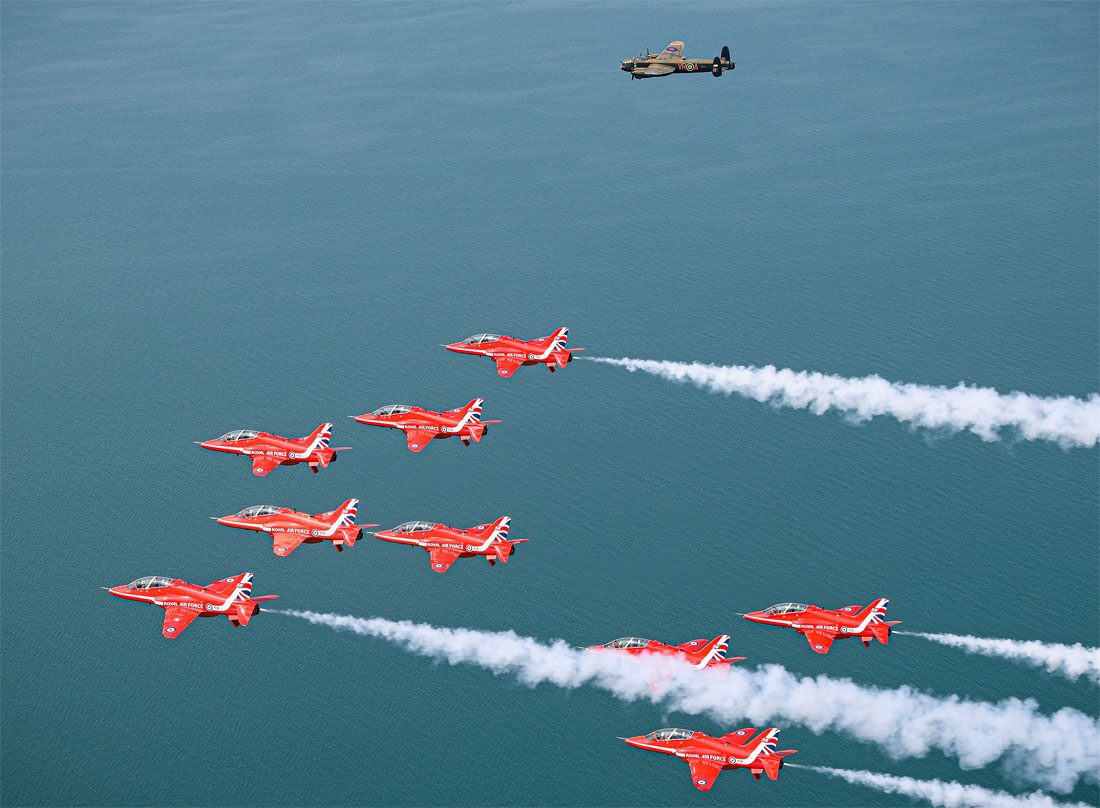
The Red Arrows with a Lancaster bomber heading to Niagara Falls - one of the high-profile flypasts of Maple Hawk
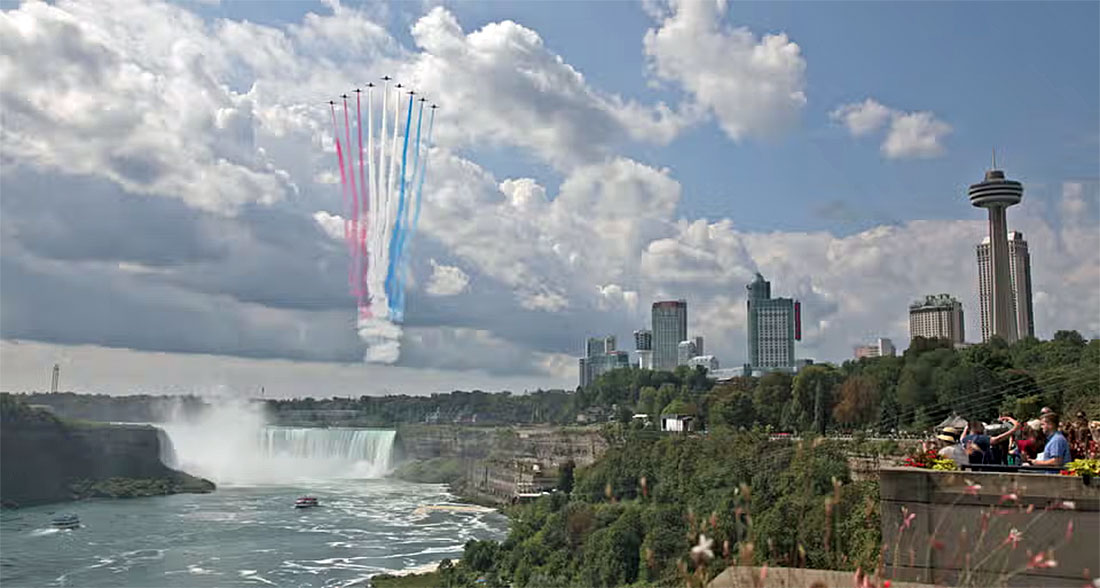
The Red Arrows wow the crowds at Niagara Falls
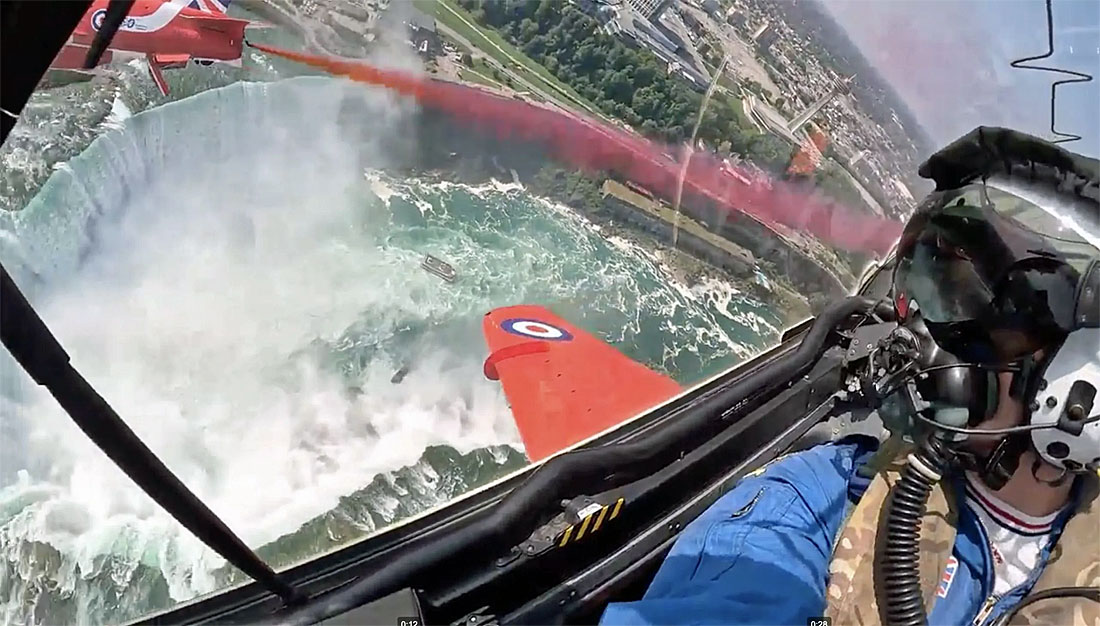
An impressive selfie by one of the Red Arrows' ground crew - known as "The Circus"
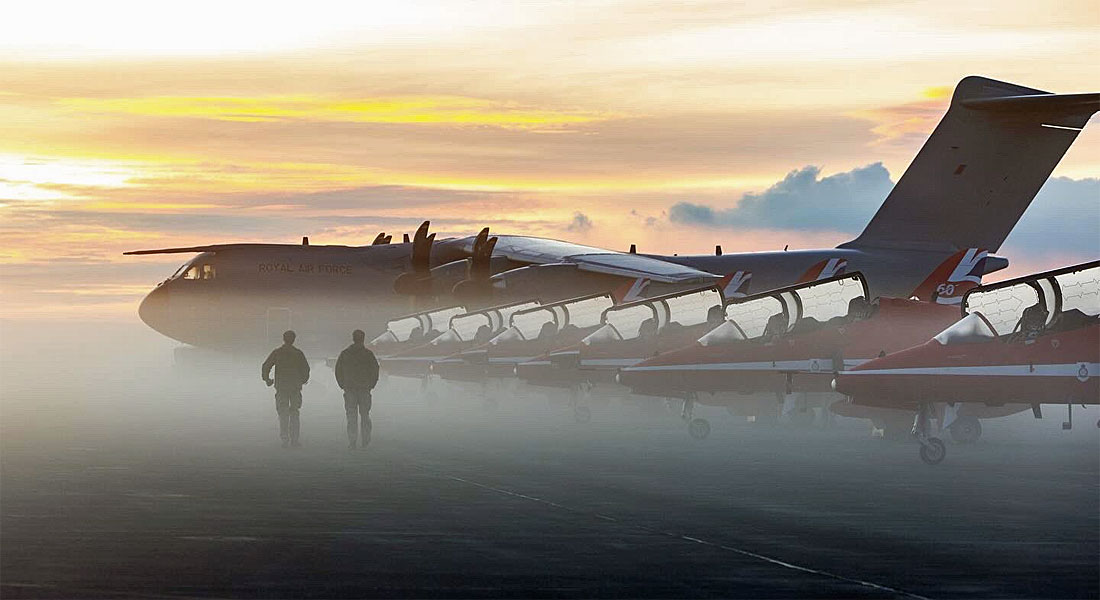
A cold start in Iceland as dawn breaks on the final stages of Red Arrows Maple Hawk
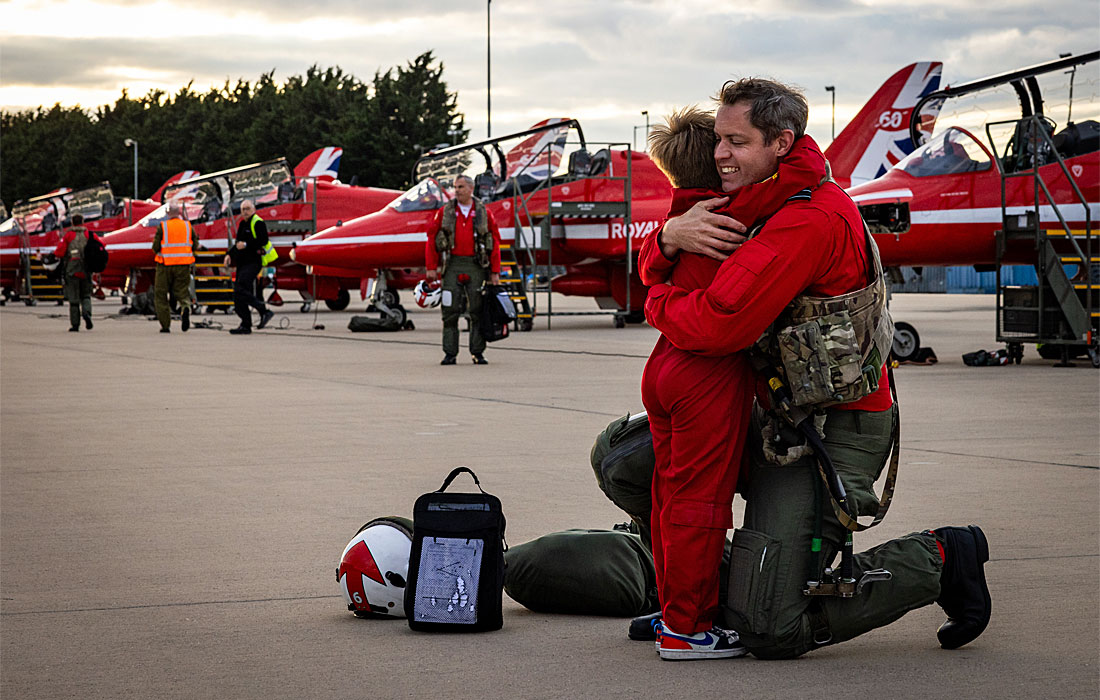
The Red Arrows are welcomed by families after returning to RAF Waddington from Canada

From: Mark Attrill, Tallinn
Subject: The worst aircraft to load
Hi Tony,
Although neither aircraft could be described as freight haulers, they were transport aircraft so my vote is with the Nord 262 and Let L-410 Turbolet. They are probably not that familiar to many but both types were used in the Balkans during my tours there, working on 'non-standard ops' (I will leave it at that).
The Nord 262 was an ancient old French Air Force twin-engine medium transport aircraft, that would not have looked out of place during WWII, with a high wing (slightly smaller than the Fokker F-27) and very difficult to trim, especially with a mixed load of passengers and freight on board (Thankfully I did not need to worry about that aspect). It was also especially entertaining to fly in at night (as we often did) since, on start up, enormous flames would erupt from the engines (which were, of course, in line of sight).
Subject: The worst aircraft to load
Hi Tony,
Although neither aircraft could be described as freight haulers, they were transport aircraft so my vote is with the Nord 262 and Let L-410 Turbolet. They are probably not that familiar to many but both types were used in the Balkans during my tours there, working on 'non-standard ops' (I will leave it at that).
The Nord 262 was an ancient old French Air Force twin-engine medium transport aircraft, that would not have looked out of place during WWII, with a high wing (slightly smaller than the Fokker F-27) and very difficult to trim, especially with a mixed load of passengers and freight on board (Thankfully I did not need to worry about that aspect). It was also especially entertaining to fly in at night (as we often did) since, on start up, enormous flames would erupt from the engines (which were, of course, in line of sight).
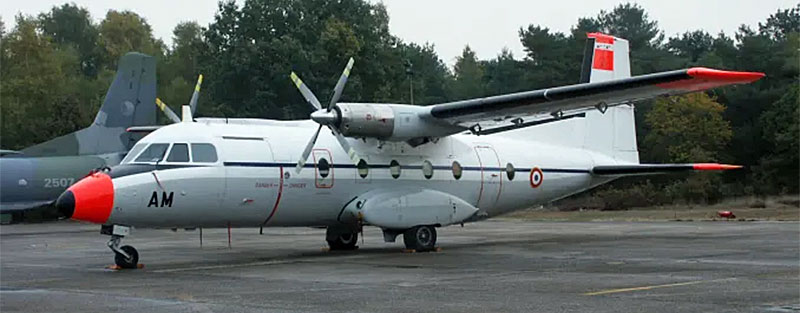
The Nord 262 - it may look 'modern' but it was not really... inside it looked like a modified C-47 Dakota
The Let L-410 Turbolet was another twin-engine, high-wing aircraft operated by the Czech and Slovenian Air Forces and OSCE during my time in Sarajevo. Another 'fun' aircraft to load due to the trim parameters and presence of beams and ribs. It was often used in the mixed pax/freight role, given the nature of what we were doing although no-one seemed to apply the rigid restraint requirements for freight and baggage that I was accustomed to.
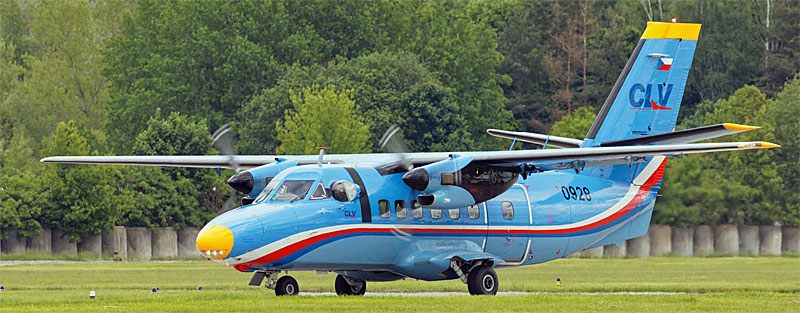
The Let L-410 Turbolet
Those two and the memorable flat floor loading of boxed ALQ-101 ECM Pods from the Buccaneers onto a C-130 at Nellis were my worst experiences although I suspect they will pale into insignificance when compared with Argosy's, Belfast's and Beverley's to name but three (before my time).
Cheers
Mark
Cheers
Mark


From: David Powell, Princes Risborough, Bucks
Subject: The worst aircraft to load
Hi Tony,
The worst aircraft to load? In terms of type, my offer is the RAF’s sloping flat floor, rear side door loading, Handley Page Hastings C1, the challenges of which have featured in several Old Bods yarns.
However, thinking about the question posed, personally my ‘worst’ was Belfast XR370 Ajax when at 0830 on the 15th December 1971 it was the last RAF Flight out of RAF Sharjah.*
Planning the last load had not been without its challenges. I didn’t make many friends by insisting on at least one casevac stretcher had to be fitted. This meant three triples lost to the PCF fit. Fortunately for me, but not for him, one of the final passengers got just a little going-home at last ‘happy’, fell off a table, broke a leg or something requiring a plaster cast first aid, and my stretcher fit was justified!
At 8 o’clock the RAF ensign was lowered for the last time. The camp fell silent as the two shots of the last pair of RAF Police guard dogs being put down echoed round the camp; their duties done, and no home-coming for them.
However, the main reason the task being my personal ‘worst’ was knowing that this would be my last ever load, last ever trim sheet, and a loading as part of a hands-on RAF movements team. Now, the world of staff appointments etc., beckoned.
I was the penultimate passenger. The station commander climbed on, we pulled up the Belfast steps as the engines started up, and RAF Sharjah was history.
Stay well, kind regards to all.
David Powell,
F Team UKMAMS Abingdon 1967-69 and Gulf MAMF 1971.
*Formally in the Trucial Oman States - Sharjah had joined the United Arab Emirates (UAE) on December 2, 1971.
Subject: The worst aircraft to load
Hi Tony,
The worst aircraft to load? In terms of type, my offer is the RAF’s sloping flat floor, rear side door loading, Handley Page Hastings C1, the challenges of which have featured in several Old Bods yarns.
However, thinking about the question posed, personally my ‘worst’ was Belfast XR370 Ajax when at 0830 on the 15th December 1971 it was the last RAF Flight out of RAF Sharjah.*
Planning the last load had not been without its challenges. I didn’t make many friends by insisting on at least one casevac stretcher had to be fitted. This meant three triples lost to the PCF fit. Fortunately for me, but not for him, one of the final passengers got just a little going-home at last ‘happy’, fell off a table, broke a leg or something requiring a plaster cast first aid, and my stretcher fit was justified!
At 8 o’clock the RAF ensign was lowered for the last time. The camp fell silent as the two shots of the last pair of RAF Police guard dogs being put down echoed round the camp; their duties done, and no home-coming for them.
However, the main reason the task being my personal ‘worst’ was knowing that this would be my last ever load, last ever trim sheet, and a loading as part of a hands-on RAF movements team. Now, the world of staff appointments etc., beckoned.
I was the penultimate passenger. The station commander climbed on, we pulled up the Belfast steps as the engines started up, and RAF Sharjah was history.
Stay well, kind regards to all.
David Powell,
F Team UKMAMS Abingdon 1967-69 and Gulf MAMF 1971.
*Formally in the Trucial Oman States - Sharjah had joined the United Arab Emirates (UAE) on December 2, 1971.

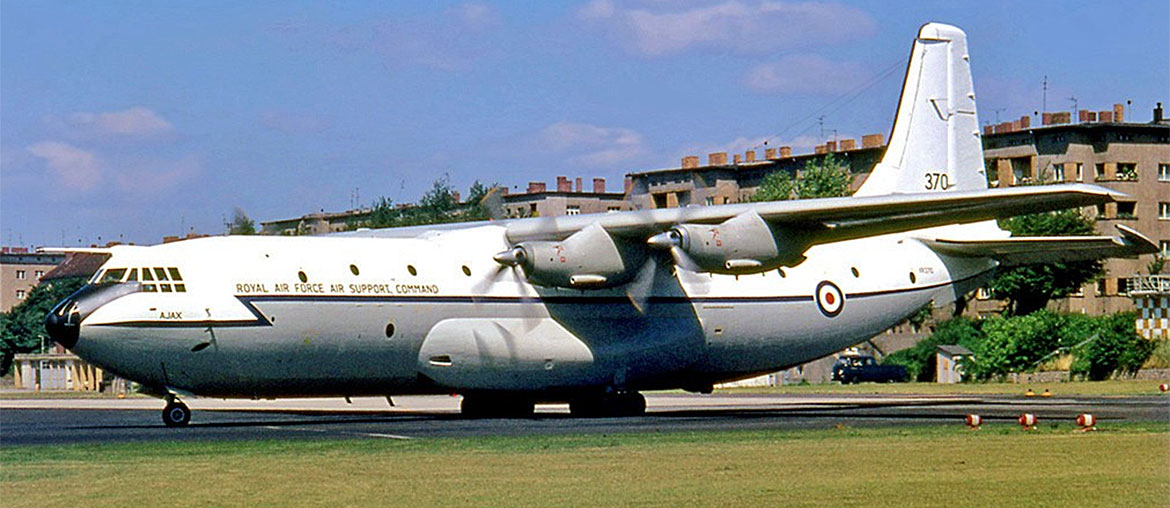
Belfast XR370 Ajax at Berlin-Templehof in July 1969

Holy Cargo: Pope Francis hitches a ride on RAAF C-130
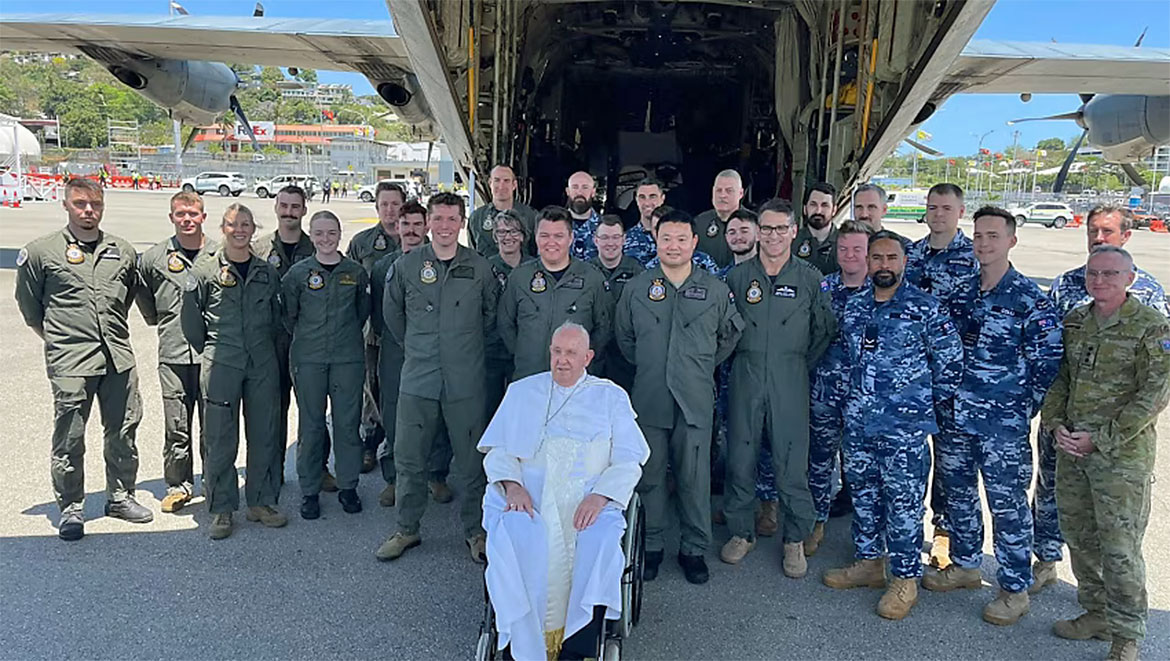
The Royal Australian Air Force has ferried head of the Catholic Church and sovereign of the Vatican City State, His Holiness Pope Francis on his travels around Papua New Guinea. He brought medicine, clothing, toys and other necessities to help people living in the remote area, according to the Vatican.
defenceconnect.com.au
defenceconnect.com.au

rom: Don Hatton, Liscomb, NS
Subject: The worst aircraft to load
Hi Tony ,
I will put the C47 Dakota at the top of the list of my least favourite a/c to load, or unload. While at 8AMU, we didn’t have any scheduled Daks and those we did have were generally in to pick up AOG’s, the AMU being co-located with 5 Supply Depot. Invariably, the AOG would be heavy and boxy. I swear the maintainers had a hate on for the air movers. The forklift could bring the freight to the door and from there it was brute strength to get it into the a/c and then it was uphill all the way, bare floor without benefit of rollers.
Subject: The worst aircraft to load
Hi Tony ,
I will put the C47 Dakota at the top of the list of my least favourite a/c to load, or unload. While at 8AMU, we didn’t have any scheduled Daks and those we did have were generally in to pick up AOG’s, the AMU being co-located with 5 Supply Depot. Invariably, the AOG would be heavy and boxy. I swear the maintainers had a hate on for the air movers. The forklift could bring the freight to the door and from there it was brute strength to get it into the a/c and then it was uphill all the way, bare floor without benefit of rollers.
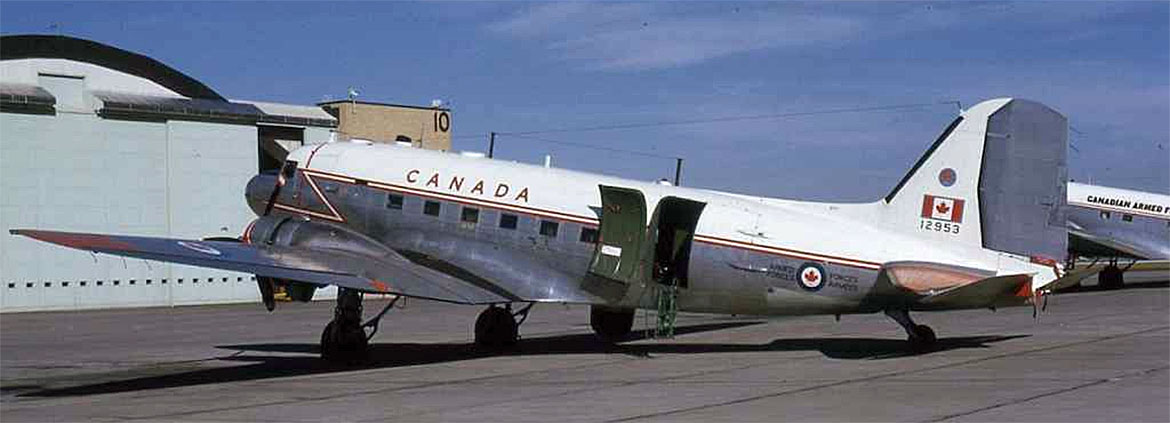
An RCAF C47 Dakota circa 1960's
While on the subject, I might as well nominate the C45 Expeditor as my favourite. Again, they dropped in to pick up an AOG, which by nature of the a/c’s payload, one could easily hand-carry the freight. Sometimes there were incoming parcels of a non-military use which did provide some fringe benefits.
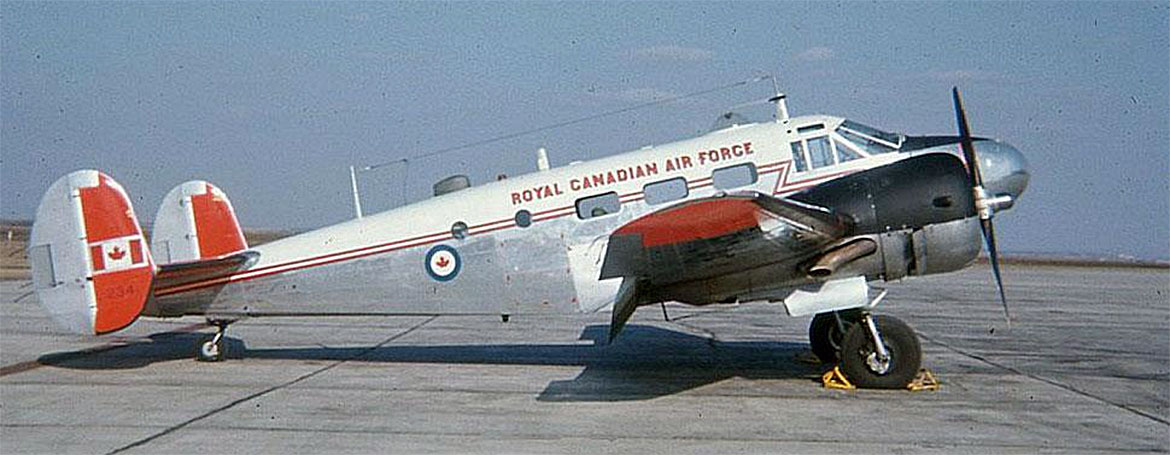
RCAF C-45 Beech Expeditor at Calgary 1967
Back in the days of ropes, chains and skate wheels, there weren’t many freighters considered a favourite, always a challenge for which we stood up, or bent for.
I await the back-breaking stories.
Don
I await the back-breaking stories.
Don


From: Pete Orton, Camberley, Surrey
Subject: The worst aircraft to load
Hello again Tony,
You can always kick off some classic nostalgia. My Junior Air Movements Course was in late 1966, as a naive 19 year old LAC I just accepted that this was what loading aeroplanes was all about. I was lucky to have been just a bit too young to have endured the York, and although then the practical test was on the Hastings, I never got to load one; at least all the floors were level in my time. In my final days as a "Duvet Tech" aka "Stacker, Blankets" at West Raynham, I watched a Hastings cartwheel off of the runway.
My apprenticeship into the world of air movements commenced at Muharraq in the summer of 67, 105 Squadron Argosy's were a treat to load, 30 Squadron Beverley's seemed to go on forever, but always allowed us several practice attempts before a serviceable air frame was found. Regular transit visiting Britannia's, Comet's, and VC-10 "Moon Rockets" provided variation to our repertoire. Being young, foolish and dim, I never disliked any of the aircraft we handled. Your observations re the Comet belly holds are valid and endorsed, but I was young and needed the money. It also prepared me for the Concorde in later life.
Subject: The worst aircraft to load
Hello again Tony,
You can always kick off some classic nostalgia. My Junior Air Movements Course was in late 1966, as a naive 19 year old LAC I just accepted that this was what loading aeroplanes was all about. I was lucky to have been just a bit too young to have endured the York, and although then the practical test was on the Hastings, I never got to load one; at least all the floors were level in my time. In my final days as a "Duvet Tech" aka "Stacker, Blankets" at West Raynham, I watched a Hastings cartwheel off of the runway.
My apprenticeship into the world of air movements commenced at Muharraq in the summer of 67, 105 Squadron Argosy's were a treat to load, 30 Squadron Beverley's seemed to go on forever, but always allowed us several practice attempts before a serviceable air frame was found. Regular transit visiting Britannia's, Comet's, and VC-10 "Moon Rockets" provided variation to our repertoire. Being young, foolish and dim, I never disliked any of the aircraft we handled. Your observations re the Comet belly holds are valid and endorsed, but I was young and needed the money. It also prepared me for the Concorde in later life.
A few years down the track, the Britannia's left Lyneham with the old SAMS movers, TAMS and our sister Herc unit from Fairford combined to rule Lyneham. By this time I was in the passenger section in the cushiest job ever, based at the Route Hotel. The only time we earned our money was with an East-Med Comet, with mega waiting lists of indulgence standby pax to be accepted after shut out. So what?
The comet was a bit nose heavy and a b'stard to trim. Late installation of pax oxygen taking up valuable baggage space in the "Dome Freight" aft compartment meant we could not trim on dead load alone, pax seating was now crucial, and MFCI tables became vital. On one memorable flight, we had to obtain actual passenger weights, at least I was allowed to "get on with it" with no SNCOs or officers getting in the way (surprisingly!). The final hour prior to departure was certainly challenging and character building. That must put the Comet in pole position for this era.
I left the industry with DCS, ULD in-plane loading and locking systems and 6-man loading teams for mega large wide body turnarounds, at least nicking unused catering hasn't changed.
Happy days!
Pete
The comet was a bit nose heavy and a b'stard to trim. Late installation of pax oxygen taking up valuable baggage space in the "Dome Freight" aft compartment meant we could not trim on dead load alone, pax seating was now crucial, and MFCI tables became vital. On one memorable flight, we had to obtain actual passenger weights, at least I was allowed to "get on with it" with no SNCOs or officers getting in the way (surprisingly!). The final hour prior to departure was certainly challenging and character building. That must put the Comet in pole position for this era.
I left the industry with DCS, ULD in-plane loading and locking systems and 6-man loading teams for mega large wide body turnarounds, at least nicking unused catering hasn't changed.
Happy days!
Pete


The first of five new C-130J-30's for the RNZAF arrives in Auckland
Highlights from the C-130J-30 Hercules Welcome Ceremony

From: Mike/Gerry Lefebvre, Burton, Oromocto, NB
Subject: The worst aircraft to load
Hi Tony,
I would like to offer my views on one of our worst loads for years with the Hercules AC — on one of our particular flights from Trenton to Alert on Baffin Island's weekly year-round and more in the summer construction months. The reason it was such a terrible job for the Loadmasters was that the load was standard pallets for most parts but they all had to be tied down by applying straps over the load and anchor chains on the bottom corners. All of this because the system weighed 2,000 lbs more than the skate wheel rollers used for this flight. This restricted the use of fuselage changes in case of unserviceability; sometimes for 24 hrs delay.
The loadmaster worked in temperatures nearing -40ºC at times in winter to the point of working a sweat due to the short turn around time allowed. Meanwhile, the front end crew went up for a delicious meal at the camp kitchen and brought back a box lunch for the Loadmasters until one of our more influential loadmasters, Aubrey Waycot (God bless him), decided to convince the rest of us to take the time to go eat whatever the consequences would be. From there on we were always going for a great meal. But no question to replace the skate wheel by the system and sacrificing 2,000 lbs of fuel.
With my thanks to Tony for his work,
Mike Lefebvre
Subject: The worst aircraft to load
Hi Tony,
I would like to offer my views on one of our worst loads for years with the Hercules AC — on one of our particular flights from Trenton to Alert on Baffin Island's weekly year-round and more in the summer construction months. The reason it was such a terrible job for the Loadmasters was that the load was standard pallets for most parts but they all had to be tied down by applying straps over the load and anchor chains on the bottom corners. All of this because the system weighed 2,000 lbs more than the skate wheel rollers used for this flight. This restricted the use of fuselage changes in case of unserviceability; sometimes for 24 hrs delay.
The loadmaster worked in temperatures nearing -40ºC at times in winter to the point of working a sweat due to the short turn around time allowed. Meanwhile, the front end crew went up for a delicious meal at the camp kitchen and brought back a box lunch for the Loadmasters until one of our more influential loadmasters, Aubrey Waycot (God bless him), decided to convince the rest of us to take the time to go eat whatever the consequences would be. From there on we were always going for a great meal. But no question to replace the skate wheel by the system and sacrificing 2,000 lbs of fuel.
With my thanks to Tony for his work,
Mike Lefebvre

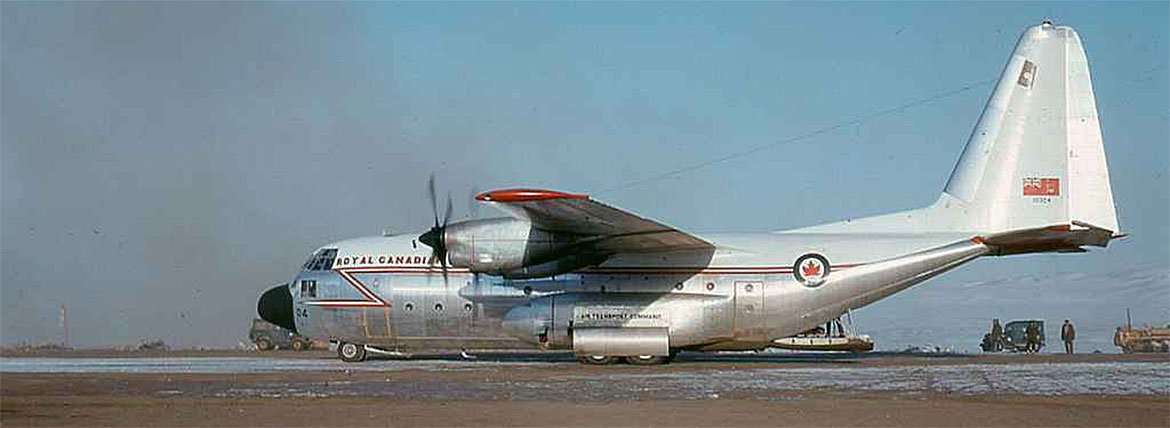

From: Dave Green, Huntingdon, Cambs
Subject: Re: UKMAMS OBA OBB #083124
Hi Tony,
Another good read. I know its sometimes a struggle to come up with yet another topic month-on-month to get contributions from us, how about a section on Movements related art work? I have attached 3 pics from Belize that could kick this off if you think it worthwhile:
Subject: Re: UKMAMS OBA OBB #083124
Hi Tony,
Another good read. I know its sometimes a struggle to come up with yet another topic month-on-month to get contributions from us, how about a section on Movements related art work? I have attached 3 pics from Belize that could kick this off if you think it worthwhile:

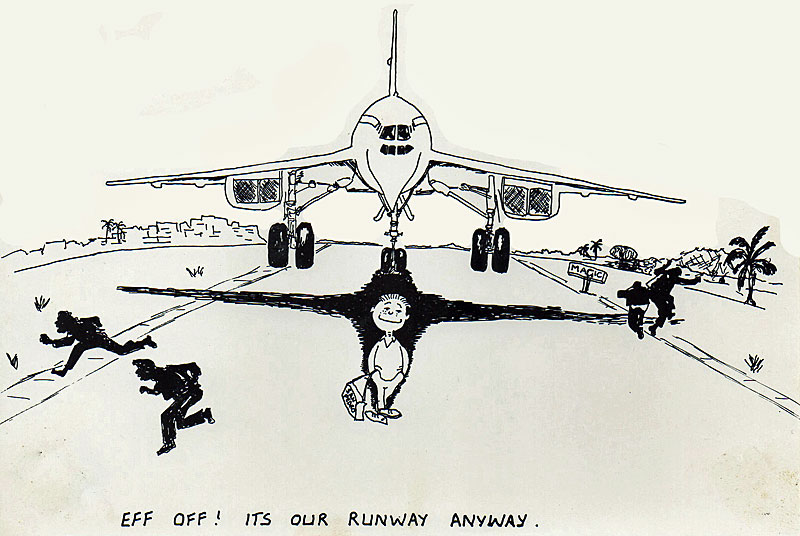
The first relating to the runway was as a result in this case of a supplier from Supply and Movements Squadron returning from a helicopter Cayes trip. He missed the Landrover back to the Airport Camp from the Helipad and couldn't be bothered to walk around the yellow brick road (about 2 miles), so he walked across the active runway to be stopped by the local police. His drunken response is evident from the picture and we had a chat when he was charged the next day!
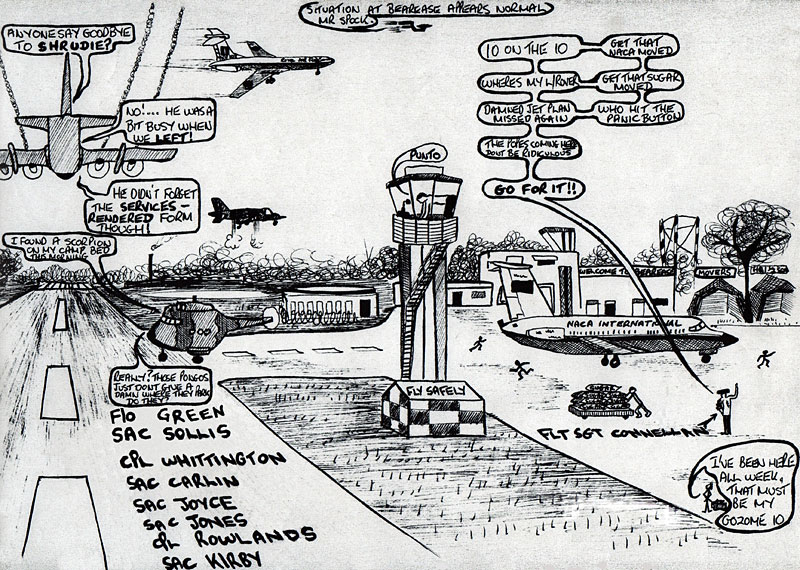
The snake cartoon is me as Fg Off Fearless when my movers found a live snake in palletised freight we left on stillage overnight to be loaded on a Herc the next morning. They were all too scared to tackle it, so armed with a broom and machete I took it on. It wasn't a grass snake but it wasn't much bigger. I winged it with the machete and it disappeared never to be seen again.
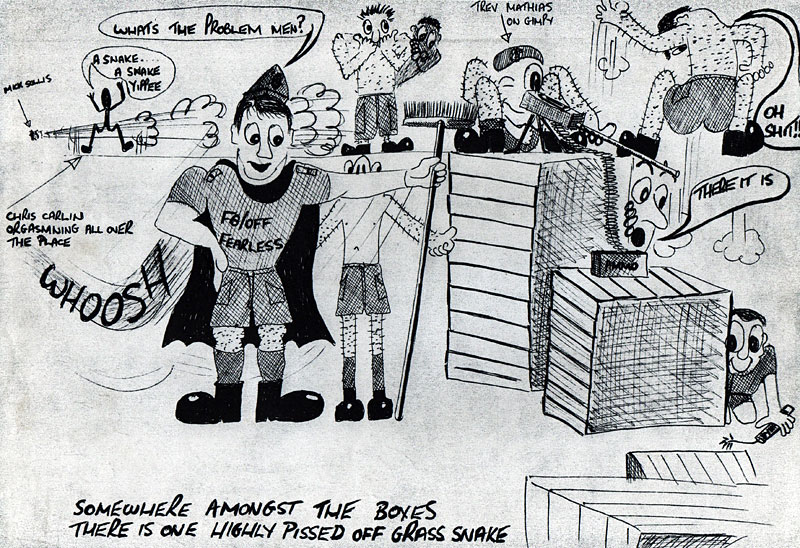
The final "Bearease" pic must have been amended hundreds of times to reflect the Movers at Belize. I recall we also had a T-shirt made up depicting a beautiful Caribbean Island scene with a VC10 overflying with a caption that read 'We Came In Search of Paradise and got diverted to Belize'.
Regards,
Dave Green
Regards,
Dave Green

From: Tony Street, Fort Erie, ON
Subject: Here's something I came across in my "Dusty" files. I'm sending it along for your entertainment.
Hi Tony,
Subject: Here's something I came across in my "Dusty" files. I'm sending it along for your entertainment.
Hi Tony,

The Newfie Airlift*
*(To the best of my recollection with some names changed to protect the guilty.)
*(To the best of my recollection with some names changed to protect the guilty.)
Early in my Air Movements career, I was sent on temporary duty to Harmon AFB near Stephenville, Newfoundland to take part in an airlift operation involving the Canadian army and RCAF Boxcars (C119’s). (This was long before the MAMs concept), I believe there were eight of us, whose names I disremember, from all over the country. We were split into two teams that would work 12 hour shifts. I made the 1900-0700 shift, lucky me.
The operation was to see about 50 Canadian Airborne Regiment troops put ashore in small boats (the Bad Guys) compliments of our Navy. They were to try to capture the south side of the base. The north side was out-of-bounds, big-time, as it housed a Strategic Airlift Command facility that serviced transiting B52 nuclear-armed bombers.
To counter the Bad Guys, the RCAF was to fly in an Army regiment (the Good Guys), of about 300 plus their equipment from the mainland, capture the Bad Guys and save the day. All is well in the planning.
Our team was on the first C119 to arrive. We set up shop in a nice office in the front corner of the huge SAC hangar. We then unloaded the next two or three aircraft (a/c), arriving with servicing bods and their equipment. With this done, we repaired to the club for refreshments, noticing the weather was turning. The Operation was to start the next day.
While we were setting up, the Bad Guys had not been idle. Their insertion onto the island was successful, but they were not “following the Op order.” Instead of camping in the woods and freezing around small fires with little cans in which to boil tea, they had taken matters into their own hands. As there were several Newfies in the group, deviousness came into play. They moved surreptitiously through the woods and arrived as close as possible to the back door of a pub near the tree line, whereupon the Newfies gave their weapons to the other non-Newfies and took off their armbands that identified them as Bad Guys.
The operation was to see about 50 Canadian Airborne Regiment troops put ashore in small boats (the Bad Guys) compliments of our Navy. They were to try to capture the south side of the base. The north side was out-of-bounds, big-time, as it housed a Strategic Airlift Command facility that serviced transiting B52 nuclear-armed bombers.
To counter the Bad Guys, the RCAF was to fly in an Army regiment (the Good Guys), of about 300 plus their equipment from the mainland, capture the Bad Guys and save the day. All is well in the planning.
Our team was on the first C119 to arrive. We set up shop in a nice office in the front corner of the huge SAC hangar. We then unloaded the next two or three aircraft (a/c), arriving with servicing bods and their equipment. With this done, we repaired to the club for refreshments, noticing the weather was turning. The Operation was to start the next day.
While we were setting up, the Bad Guys had not been idle. Their insertion onto the island was successful, but they were not “following the Op order.” Instead of camping in the woods and freezing around small fires with little cans in which to boil tea, they had taken matters into their own hands. As there were several Newfies in the group, deviousness came into play. They moved surreptitiously through the woods and arrived as close as possible to the back door of a pub near the tree line, whereupon the Newfies gave their weapons to the other non-Newfies and took off their armbands that identified them as Bad Guys.
These chaps went into the pub and were met with open arms and Newfoundland hospitality. After a few rounds and games of darts they revealed their true reason for being there. The Newfies loved it (“Bleedin’ Mainlanders and Yanks takin’ over da world! Well, not ‘ere, eh, lads?”), and before long all the Bad Guys were “warmin’ demselves” in the pub’s basement.
It came to pass that some of the local Newfies worked on Harmon AFB in the messes, clubs and the Motor Pool. Therefore, it should not be surprising that the next day the Newfs entered the base to report for work, they had an advance party of as many Bad Guys as could be stuffed into the trunks of their cars. These guys quickly stole a jeep (more on this later), from behind the hangar and cut a hole in the fence allowing entrance to the rest of the Bad Guys.
Meanwhile, our operation had started. The Boxcars were arriving at three hour intervals in steadily deteriorating weather. By the time our shift reported to work things were going to hell in a hand basket. The winds were fierce, driving the snow horizontally and stinging exposed skin. It was impossible to see anything without the protection of goggles.
When the first C119s arrived they had the clam-shell doors installed, however he wind became so strong that it was impossible to open them without damage or injury. It also was becoming increasingly dangerous to taxi the a/c into the marshalling area.
The portable gas driven hangar line lighting units were being blown around like match sticks. One of the Air Movers, seeing a lighting unit being blown towards a C119’s running engine, rammed it into a snow bank with his vehicle. It was time for “a reassessment of the operational requirements vis-à-vis conditions on the ground!” (Read: Plan B).
The Army’s original plan was to house all the vehicles and supplies in the hangar. The troops would erect a pleasant, roomy campground for themselves behind the hangar.
To this end, under a blaze of our portable lighting units, a Lt. showed up behind the hangar and told the Company Sargeant Major (CSM) to start erecting tents. “I don’t think that’s a good idea, Sir, considering the weather.”
“Nonsense insisted the Lt. “There’s no problem; I’ve been camping before in weather like this,” as he wrestled with a large rolled up tent. “I’ll align the first one with the Ops plan and the men can carry on down the line,” he said as he reached for the rope that secured the tent.
It came to pass that some of the local Newfies worked on Harmon AFB in the messes, clubs and the Motor Pool. Therefore, it should not be surprising that the next day the Newfs entered the base to report for work, they had an advance party of as many Bad Guys as could be stuffed into the trunks of their cars. These guys quickly stole a jeep (more on this later), from behind the hangar and cut a hole in the fence allowing entrance to the rest of the Bad Guys.
Meanwhile, our operation had started. The Boxcars were arriving at three hour intervals in steadily deteriorating weather. By the time our shift reported to work things were going to hell in a hand basket. The winds were fierce, driving the snow horizontally and stinging exposed skin. It was impossible to see anything without the protection of goggles.
When the first C119s arrived they had the clam-shell doors installed, however he wind became so strong that it was impossible to open them without damage or injury. It also was becoming increasingly dangerous to taxi the a/c into the marshalling area.
The portable gas driven hangar line lighting units were being blown around like match sticks. One of the Air Movers, seeing a lighting unit being blown towards a C119’s running engine, rammed it into a snow bank with his vehicle. It was time for “a reassessment of the operational requirements vis-à-vis conditions on the ground!” (Read: Plan B).
The Army’s original plan was to house all the vehicles and supplies in the hangar. The troops would erect a pleasant, roomy campground for themselves behind the hangar.
To this end, under a blaze of our portable lighting units, a Lt. showed up behind the hangar and told the Company Sargeant Major (CSM) to start erecting tents. “I don’t think that’s a good idea, Sir, considering the weather.”
“Nonsense insisted the Lt. “There’s no problem; I’ve been camping before in weather like this,” as he wrestled with a large rolled up tent. “I’ll align the first one with the Ops plan and the men can carry on down the line,” he said as he reached for the rope that secured the tent.
“I wouldn’t do that, Sir.” cautioned the CSM.
“I know what I’m doing, CSM, I’ve been camping a time or two” said the Lt. With that he gave the rope a manly tug that activated the quick-release knot.
It was wonderful to watch Father Nature at work! The wind immediately caught the tent, unrolled it, and with a loud crack, opened it to its full size and shape just before it was carried off through the cone of snow-swept light, into the black hole of night.
“Apparently not.” said the RSM
(I hear later that it was recovered in downtown Stevensville and hidden in the pub’s basement until we went away).
This changed the “reassessment of the operational requirements vis-à-vis conditions on the ground!” (Plan B), Now, the vehicles were to be positioned outside in the lee of the hangar and the troops inside.
Meanwhile, back on the flight line, the situation had become untenable; it was now unsafe to marshal the empty and lighter a/c as side winds could blow them over. A meeting was held (what else!?). It appeared that this was a very important tri-service exercise (Navy involved in re-deployment), and was to set an example for future ops. Besides, “We’re here now, eh, pity to waste the opportunity, Yanks won’t let us back in.”
Our Ops HQ on the mainland was called and the following procedure agreed upon. The 119’s would fly without the clam-shell doors. As the wind was directly down the runway in a direction that favored this, the a/c would land on the numbers and taxi into the wind and stop at the intersection of the taxiway to our hangar, a short distance away. The pilot would maintain his position using power and brakes. We would then unload the a/c using standard procedures. It worked!
Now all the pilot had to do to get airborne with his empty a/c was to release the brakes and add a few knots.
The vehicles, troops and equipment thus unloaded went directly to the hangar. The vehicles would be unloaded and parked outside behind the hangar (This is where the Bad Guys got their jeep). The troops would roll out their fart sacks in one of the increasingly long rows of troops growing on the hangar floor, eventually to number 300! The hangar was pleasant enough; we had heat and light, although the arc lights did nothing for one’s skin tone.
“I know what I’m doing, CSM, I’ve been camping a time or two” said the Lt. With that he gave the rope a manly tug that activated the quick-release knot.
It was wonderful to watch Father Nature at work! The wind immediately caught the tent, unrolled it, and with a loud crack, opened it to its full size and shape just before it was carried off through the cone of snow-swept light, into the black hole of night.
“Apparently not.” said the RSM
(I hear later that it was recovered in downtown Stevensville and hidden in the pub’s basement until we went away).
This changed the “reassessment of the operational requirements vis-à-vis conditions on the ground!” (Plan B), Now, the vehicles were to be positioned outside in the lee of the hangar and the troops inside.
Meanwhile, back on the flight line, the situation had become untenable; it was now unsafe to marshal the empty and lighter a/c as side winds could blow them over. A meeting was held (what else!?). It appeared that this was a very important tri-service exercise (Navy involved in re-deployment), and was to set an example for future ops. Besides, “We’re here now, eh, pity to waste the opportunity, Yanks won’t let us back in.”
Our Ops HQ on the mainland was called and the following procedure agreed upon. The 119’s would fly without the clam-shell doors. As the wind was directly down the runway in a direction that favored this, the a/c would land on the numbers and taxi into the wind and stop at the intersection of the taxiway to our hangar, a short distance away. The pilot would maintain his position using power and brakes. We would then unload the a/c using standard procedures. It worked!
Now all the pilot had to do to get airborne with his empty a/c was to release the brakes and add a few knots.
The vehicles, troops and equipment thus unloaded went directly to the hangar. The vehicles would be unloaded and parked outside behind the hangar (This is where the Bad Guys got their jeep). The troops would roll out their fart sacks in one of the increasingly long rows of troops growing on the hangar floor, eventually to number 300! The hangar was pleasant enough; we had heat and light, although the arc lights did nothing for one’s skin tone.
In spite of all this, the operation was going swimmingly (from the Army’s standpoint). They sent out regular patrols seeking Bad Guys with no results. “I hope they’re not frozen in the woods,” remarked a Lt.
I should explain our office set-up here. As you know, we had a nice corner office into which we had brought all our goodies. (Nothing like the flyaway MAMS kits of the future.). We had several standard USAF issue chairs and desks (2).
The Army inhabited the adjoining office, one of many running down the side of the hangar. They had a 10’ conference table and chairs and a desk on the other side of the wall from ours. We shared a phone, which pissed off the Colonel (and everybody else, for that matter).
The phone was sitting on a little metal tray on the end of a two foot long arm that swung through a hole in the wall. (Ring: “Ops hangar, airman Street, here, Sir.” May I speak to “Colonel Canada,” airman Street?” Swing: “It’s for you.” This got me a visit from the RSM).
I remember overhearing a briefing at the “Big Table,” as the army referred to it. LtCol, to Lt. “I want you to find the insurgents, so take a jeep and a squad and proceed to coordinates, 1234 and 4321 on the map here.”
The Lt., after referring to his Binder, map, Junior Officer Leadership, Khaki, Field Ops Kit. Replied, “I can’t find it here, sir”
The LtCol banging on the map on the Big Table with his forefinger, “Look, Here! At the coordinates, man, can you not see 1234/4321? It’s right here, at the fork in the road!”
“Yes Sir!” Was the weak reply, “But, Sir, I don’t have that map in my binder, Sir!”
“Well then, just take the squad to the base dump and look around, it’s right at the fork in the road,”
The exercise went on merrily without any Bad Guys being seen, the patrols went out regularly after the morning and evening briefing around the Big Table but came back empty handed. Boredom was setting in, until things took a turn for the worse or the better, depending upon who you were.
I should explain our office set-up here. As you know, we had a nice corner office into which we had brought all our goodies. (Nothing like the flyaway MAMS kits of the future.). We had several standard USAF issue chairs and desks (2).
The Army inhabited the adjoining office, one of many running down the side of the hangar. They had a 10’ conference table and chairs and a desk on the other side of the wall from ours. We shared a phone, which pissed off the Colonel (and everybody else, for that matter).
The phone was sitting on a little metal tray on the end of a two foot long arm that swung through a hole in the wall. (Ring: “Ops hangar, airman Street, here, Sir.” May I speak to “Colonel Canada,” airman Street?” Swing: “It’s for you.” This got me a visit from the RSM).
I remember overhearing a briefing at the “Big Table,” as the army referred to it. LtCol, to Lt. “I want you to find the insurgents, so take a jeep and a squad and proceed to coordinates, 1234 and 4321 on the map here.”
The Lt., after referring to his Binder, map, Junior Officer Leadership, Khaki, Field Ops Kit. Replied, “I can’t find it here, sir”
The LtCol banging on the map on the Big Table with his forefinger, “Look, Here! At the coordinates, man, can you not see 1234/4321? It’s right here, at the fork in the road!”
“Yes Sir!” Was the weak reply, “But, Sir, I don’t have that map in my binder, Sir!”
“Well then, just take the squad to the base dump and look around, it’s right at the fork in the road,”
The exercise went on merrily without any Bad Guys being seen, the patrols went out regularly after the morning and evening briefing around the Big Table but came back empty handed. Boredom was setting in, until things took a turn for the worse or the better, depending upon who you were.
Remember, the Strategic Air Command (SAC) side of the field was sacrosanct, as was the runway. But wouldn’t you just know it, the USAF air traffic controller looked out his window and saw four happy Bad Guys screaming down their 10,000 foot runway in the stolen jeep waving their black arm bands in the wind! Upon reaching the midpoint, they tossed out a rucksack full of rocks with a label on it saying “Boom! I’m a bomb. You now have two 5000 foot runways! (The message was also written in Canada’s second language, but I suppose the extra effort was wasted on the Yanks). Phones rang both here and on the mainland.
Messages were flashed across all available means to let all and sundry know we had been out of bounds! Any further incursion to SAC Land would be met by a surgical nuclear strike against Come By Chance, a pleasant little town in Newfoundland (somewhere).
The Bad Guys had thought that blowing up the runway into two segments would, technically, halt the airlift. Not so, although the winds had abated some they were still high enough to land the C119s in 5000 feet. “Rat’s, well there’s always tomorrow.”
The next day was a repeat of the day before; instead, we now had four 2,500 foot long runways! This time Ottawa got involved.
These two days were the only indications that the Good Guys were on the island (They had not notice the two missing jeeps in the tangle of snow drifted vehicles behind the hangar). This was soon to change.
Activities in the hangar had fallen into some kind of routine. The incoming vehicles from the a/c now had to approach the hangar door and tootle a daily changing code on their horns. The DD (Duty Doorman) would press the button(s) that would open the 75 foot high hangar door, the vehicle would enter etc. I’m glad I was there to witness what occurred that night.
Everything was motoring along smoothly; we had rotated through the meal hour and were settling down for a long boring night as we would only have two more arrivals.
All of a sudden the lights and heat went out. It was later determined that the Bad Guys had sabotaged the systems control panel outside behind the hangar.
The RSM, not forgetting years of training, immediately shouted,” Someone, turn on a flashlight!”
CLICK: On came 300 Torches, Electric, Two Cell, Plastic, Clear Lens (90* Neck). It was as bright as the surface of the sun!
The CSM countermanded his last order, “Turn the bloody things off!”
CLICK: Bang! It was blacker than the inside of a cow. (Except for the little balls of light ricocheting about on the surfaces of our retinas).
The CSM, having re-considered his position, asked, “Can I have just a few flashlights on?”
Not knowing who should turn their flashlights on, there were many subdued CLICKS as the lighting moved in tiny increments slowly toward solar level.
The CSM pointed, “You there, in the front row…what’s your name?”
“Collins,” was the reply.
“Good man, Collins, keep your flashlight on and the remainder of you, OFF FLASHLIGHTS!”
One could see by Collin’s light…but no so much.
Messages were flashed across all available means to let all and sundry know we had been out of bounds! Any further incursion to SAC Land would be met by a surgical nuclear strike against Come By Chance, a pleasant little town in Newfoundland (somewhere).
The Bad Guys had thought that blowing up the runway into two segments would, technically, halt the airlift. Not so, although the winds had abated some they were still high enough to land the C119s in 5000 feet. “Rat’s, well there’s always tomorrow.”
The next day was a repeat of the day before; instead, we now had four 2,500 foot long runways! This time Ottawa got involved.
These two days were the only indications that the Good Guys were on the island (They had not notice the two missing jeeps in the tangle of snow drifted vehicles behind the hangar). This was soon to change.
Activities in the hangar had fallen into some kind of routine. The incoming vehicles from the a/c now had to approach the hangar door and tootle a daily changing code on their horns. The DD (Duty Doorman) would press the button(s) that would open the 75 foot high hangar door, the vehicle would enter etc. I’m glad I was there to witness what occurred that night.
Everything was motoring along smoothly; we had rotated through the meal hour and were settling down for a long boring night as we would only have two more arrivals.
All of a sudden the lights and heat went out. It was later determined that the Bad Guys had sabotaged the systems control panel outside behind the hangar.
The RSM, not forgetting years of training, immediately shouted,” Someone, turn on a flashlight!”
CLICK: On came 300 Torches, Electric, Two Cell, Plastic, Clear Lens (90* Neck). It was as bright as the surface of the sun!
The CSM countermanded his last order, “Turn the bloody things off!”
CLICK: Bang! It was blacker than the inside of a cow. (Except for the little balls of light ricocheting about on the surfaces of our retinas).
The CSM, having re-considered his position, asked, “Can I have just a few flashlights on?”
Not knowing who should turn their flashlights on, there were many subdued CLICKS as the lighting moved in tiny increments slowly toward solar level.
The CSM pointed, “You there, in the front row…what’s your name?”
“Collins,” was the reply.
“Good man, Collins, keep your flashlight on and the remainder of you, OFF FLASHLIGHTS!”
One could see by Collin’s light…but no so much.
“The two men on either side of Collins, FLASHLIGHTS ON!” requested the CSM. CLICK: The CSM, to himself, “F**kin’ A.”
The Good Guys had to break into the supplies stacked in the rear of the hangar to retrieve the Coleman lanterns they didn’t expect to use as they were not camping. Even with the heat generated by the many lanterns, with the icy wind swirling and moaning around the hangar and seeking entrance, it got cold.
The next day dawned nice and clear, the wind was negligible. Vehicles were dug out and a domestic day was had. All the nitnoy things that remained undone due to the weather were put right. The routine patrols went out and jobs were found for all. The Good Guys were even talking about a BBQ for dins. In spite of the four 2500 foot runway situation, it was chosen to ignore it completely. “Why, as we weren’t supposed to be there, we weren’t, so it didn’t happen…Right, gentlemen? Carry on!”
As the deployment was over, we on the night shift, had the night off. We spent it in the pleasant surroundings of the NCO Club and had a nice sleep-in next morning. We were to work that night as there were a couple of VIP arrivals. I’m glad we did.
The VIP a/c landed within 20 minutes of each other. The VIPs were the Regimental Commander plus staff and some senior Army fellows and hangers-on from Ottawa. All were milling about in the adjoining conference room, 300 God Guys in or on their farters reading, playing cards, whatever, when from outside there came a tootle (in the day’s code), from someone seeking admittance. The DD rose and opened the door. When it was open wide enough to admit a stolen jeep, it roared inside, in reverse gear, carrying four, count ‘em, four, grinning Bad Guys. One of them manned a mounted machine gun; the two in the rear rose up and threw two dummy flashbangs, one to each end of the hanger. They were gone as fast as they had appeared. BOOM, BOOM!
The operation was over. The base belonged to the Bad Guys as all the Good Guys were dead.
Bedlam! The Colonel came unglued! He screamed at a couple of Captains standing idle, “Get on that jeep and find those b*****s. If they don’t come gently, bring ‘em anyway. GO!” He added, “If you can’t find them, don’t come back yourselves, you’re finished!” Reassuring.
The Good Guys had to break into the supplies stacked in the rear of the hangar to retrieve the Coleman lanterns they didn’t expect to use as they were not camping. Even with the heat generated by the many lanterns, with the icy wind swirling and moaning around the hangar and seeking entrance, it got cold.
The next day dawned nice and clear, the wind was negligible. Vehicles were dug out and a domestic day was had. All the nitnoy things that remained undone due to the weather were put right. The routine patrols went out and jobs were found for all. The Good Guys were even talking about a BBQ for dins. In spite of the four 2500 foot runway situation, it was chosen to ignore it completely. “Why, as we weren’t supposed to be there, we weren’t, so it didn’t happen…Right, gentlemen? Carry on!”
As the deployment was over, we on the night shift, had the night off. We spent it in the pleasant surroundings of the NCO Club and had a nice sleep-in next morning. We were to work that night as there were a couple of VIP arrivals. I’m glad we did.
The VIP a/c landed within 20 minutes of each other. The VIPs were the Regimental Commander plus staff and some senior Army fellows and hangers-on from Ottawa. All were milling about in the adjoining conference room, 300 God Guys in or on their farters reading, playing cards, whatever, when from outside there came a tootle (in the day’s code), from someone seeking admittance. The DD rose and opened the door. When it was open wide enough to admit a stolen jeep, it roared inside, in reverse gear, carrying four, count ‘em, four, grinning Bad Guys. One of them manned a mounted machine gun; the two in the rear rose up and threw two dummy flashbangs, one to each end of the hanger. They were gone as fast as they had appeared. BOOM, BOOM!
The operation was over. The base belonged to the Bad Guys as all the Good Guys were dead.
Bedlam! The Colonel came unglued! He screamed at a couple of Captains standing idle, “Get on that jeep and find those b*****s. If they don’t come gently, bring ‘em anyway. GO!” He added, “If you can’t find them, don’t come back yourselves, you’re finished!” Reassuring.
In the dead of night three jeeps quickly left the hangar and sped off into the darkness. Each jeep had a Captain at the wheel and two MPs in it.
The officers left behind had an “O’ group to figure out what had happened. “They flash banged us illegally,” said one, “As we’re in a SAC hangar and SAC facilities are out of bounds, we’re safe, aren’t we?” mewled one.
“This whole base is a frikkin’ SAC facility,” replied another. The arguments went on into the wee hours.
About dawn, the jeeps returned with the miscreants, all of whom looked worse for wear. Apparently, they had “resisted arrest” and had to be “dealt with accordingly!” said the arresting MPs. There was no supporting response from the Captain.
The Colonel, white with anger, approached the black-banded Corporal and enquired, quietly, “Just what the f***k do you think you’re doing, soldier? Don’t you read your f*****g Op orders? Don’t you know this hangar is neutral territory and out-of-bounds, you a*****e?” he concluded venomously. This scene was played out to the amusement of all.
The Corporal drew himself to his full height, smiled and replied, “War is hell, Colonel!” I think the smile did it, the nearest MP gut-punched him doubling him over. It’s to his credit he didn’t puke. It took the RSM and a couple of Captains a while to calm the 300 troops. The other Bad Guys were rounded up and the game was over.
We left shortly thereafter as the Army was to clean up and transport everything back by surface means. We spent two days decompressing in the NCO Club and then we wended our ways home to tell others of our “Grand Newfie Adventure.”
The officers left behind had an “O’ group to figure out what had happened. “They flash banged us illegally,” said one, “As we’re in a SAC hangar and SAC facilities are out of bounds, we’re safe, aren’t we?” mewled one.
“This whole base is a frikkin’ SAC facility,” replied another. The arguments went on into the wee hours.
About dawn, the jeeps returned with the miscreants, all of whom looked worse for wear. Apparently, they had “resisted arrest” and had to be “dealt with accordingly!” said the arresting MPs. There was no supporting response from the Captain.
The Colonel, white with anger, approached the black-banded Corporal and enquired, quietly, “Just what the f***k do you think you’re doing, soldier? Don’t you read your f*****g Op orders? Don’t you know this hangar is neutral territory and out-of-bounds, you a*****e?” he concluded venomously. This scene was played out to the amusement of all.
The Corporal drew himself to his full height, smiled and replied, “War is hell, Colonel!” I think the smile did it, the nearest MP gut-punched him doubling him over. It’s to his credit he didn’t puke. It took the RSM and a couple of Captains a while to calm the 300 troops. The other Bad Guys were rounded up and the game was over.
We left shortly thereafter as the Army was to clean up and transport everything back by surface means. We spent two days decompressing in the NCO Club and then we wended our ways home to tell others of our “Grand Newfie Adventure.”

From: Mark Attrill, Tallinn
Subject: Belize – Appeal for help
Hello again Tony,
Next year will be the 50th Anniversary of the first deployment of BAe Harriers to Belize in what would become a long-term commitment to this far flung outpost. I am involved in a project to commemorate the role of the Harrier in the reinforcement of the Belize Garrison and we are looking for reference photographs taken over the 1970-90s. We are particularly interested in any photographs that portray those aircraft that sported the nose and tail art (or zaps) that became almost legendary in Belize. I know that many members of the Association had previously served in Belize and feel sure that among the membership there will be some who took (or acquired) photographs of the Harriers 'in theatre', so I would be very interested if they were able to share scans of them with me, to help out with our research of the project.
Many Thanks,
Mark A
(Click on the flags above to send an e-mail to Mark)
Subject: Belize – Appeal for help
Hello again Tony,
Next year will be the 50th Anniversary of the first deployment of BAe Harriers to Belize in what would become a long-term commitment to this far flung outpost. I am involved in a project to commemorate the role of the Harrier in the reinforcement of the Belize Garrison and we are looking for reference photographs taken over the 1970-90s. We are particularly interested in any photographs that portray those aircraft that sported the nose and tail art (or zaps) that became almost legendary in Belize. I know that many members of the Association had previously served in Belize and feel sure that among the membership there will be some who took (or acquired) photographs of the Harriers 'in theatre', so I would be very interested if they were able to share scans of them with me, to help out with our research of the project.
Many Thanks,
Mark A
(Click on the flags above to send an e-mail to Mark)


From Royal Air Force News, May 25, 1990: Squadron Leader Colin Gower, RAFVR, joined a team from UKMAMS to take part in Exercise Gallant Cossack. He also found out how they maintain their reputation for being...
SWIFT TO MOVE
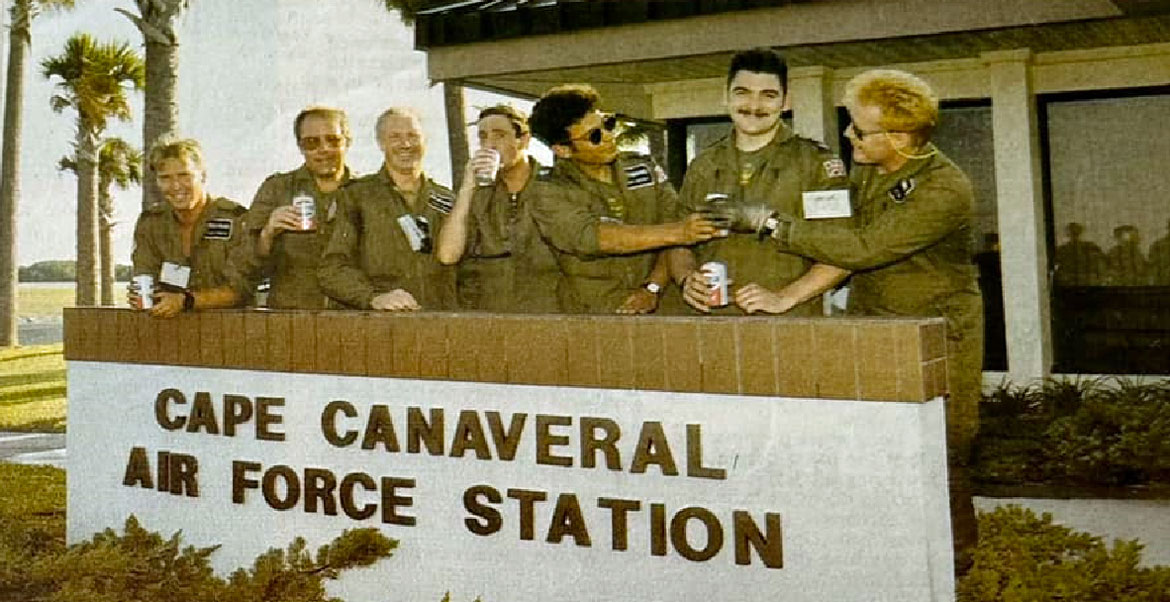
UKMAMS team take a break for a refreshing drink at Canaveral: (L to R) Flt Lt Simon Hawkins, Sgt Clive Bishop, Sgt Colin Hawson, Cpl Steve Burke, Cpl Mick Gidney, Cpl Dave Swetman and SAC "Flash" O'Neil
'Swift to Move' is the motto of a squadron of some of the most dedicated members of the RAF. For this motto, on a badge that shows a swift and the four cardinal points of the compass, gives a clue to the role of a team of some of the busiest members of the present day Royal Air Force.
RAF Lyneham is home to four squadrons of Hercules transport aircraft and also to No.242 Operation Conversion Unit (one of the largest flying units in the RAF. But the vast airfield is also headquarters of the United Kingdom Mobile Air Movements Squadron (UKMAMS) whose members are frequently expected to live up to their motto.
Wing Commander Barrie Hay, Officer Commanding UKMAMS, explains: "The main task of the Wiltshire station is to ensure that these four-engine transport aircraft operate efficiently when tasked to fly personnel and freight around the world. In effect, the entire Hercules fleet is trained, operated and supported from the one base. The role of UKMAMS is straight forward. We load and unload freight , baggage and passengers wherever we are tasked."
RAF Lyneham is home to four squadrons of Hercules transport aircraft and also to No.242 Operation Conversion Unit (one of the largest flying units in the RAF. But the vast airfield is also headquarters of the United Kingdom Mobile Air Movements Squadron (UKMAMS) whose members are frequently expected to live up to their motto.
Wing Commander Barrie Hay, Officer Commanding UKMAMS, explains: "The main task of the Wiltshire station is to ensure that these four-engine transport aircraft operate efficiently when tasked to fly personnel and freight around the world. In effect, the entire Hercules fleet is trained, operated and supported from the one base. The role of UKMAMS is straight forward. We load and unload freight , baggage and passengers wherever we are tasked."
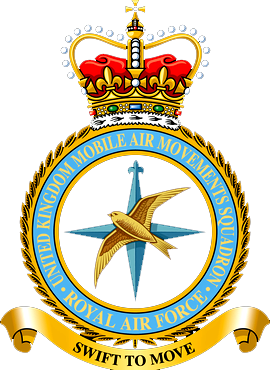
Almost 30 personnel working shifts annually handle over 15, 500 tons of freight. Most, but not all the aircraft are C130s (Hercules). But MAMS have handled a Russian AN12 as well as Dutch F27. Some of the more unusual loads have included : Polo ponies, a Rolls Royce for King Hussein of Jordan, gaming machines and lorry loads of beer.
The squadron is divided into three flights; Base, Mobile and Support and Training. Base Flight is commanded by a squadron leader who has four shits which operate from the air terminal at Lyneham and Brize Norton, the air transport sister station near Oxford. Base Movements Operations oversee all base operations including aircraft paperwork, liaise with the aircraft captain and ensure that safety regulations are strictly adhered to.
To witness at first hand how the mobile teams operate, I was invited to join them on Exercise Gallant Cossack which, I was told, involved Royal Navy submarines at Andros, a small island in the Bahamas about 150 miles south-east of Miami, Florida.
The Atlantic Undersea Test and Evaluation Centre (AUTEC) has a unit at the US Naval Base on the island and UKMAMS were to play their part in Gallant Cossack by air freighting equipment for the Royal Navy who fire Stingray and Spearfish torpedoes at targets which are positioned in a specially dug channel a few miles offshore. The results of these tests are of course classified but Mr Orion Young, the UK AUTEC Support Manager, pointed out that any friendly nation can hire the permanent ranges, which are very much in demand and expensive. Because the RN pay for their use by the day, a lot depends on the RAF support unit being in the right place at the right time.
The squadron is divided into three flights; Base, Mobile and Support and Training. Base Flight is commanded by a squadron leader who has four shits which operate from the air terminal at Lyneham and Brize Norton, the air transport sister station near Oxford. Base Movements Operations oversee all base operations including aircraft paperwork, liaise with the aircraft captain and ensure that safety regulations are strictly adhered to.
To witness at first hand how the mobile teams operate, I was invited to join them on Exercise Gallant Cossack which, I was told, involved Royal Navy submarines at Andros, a small island in the Bahamas about 150 miles south-east of Miami, Florida.
The Atlantic Undersea Test and Evaluation Centre (AUTEC) has a unit at the US Naval Base on the island and UKMAMS were to play their part in Gallant Cossack by air freighting equipment for the Royal Navy who fire Stingray and Spearfish torpedoes at targets which are positioned in a specially dug channel a few miles offshore. The results of these tests are of course classified but Mr Orion Young, the UK AUTEC Support Manager, pointed out that any friendly nation can hire the permanent ranges, which are very much in demand and expensive. Because the RN pay for their use by the day, a lot depends on the RAF support unit being in the right place at the right time.
On this occasion, one C130 was in-theatre at Patrick Air Force Base which is on the mainland a few miles from Canaveral Space Center. This aircraft commuted to Andros with cargos of torpedoes, targets and test equipment. The kit was uplifted from the airstrip at Canaveral and flown to the island strip. Once there, the MAMS detachment, under the command of Flt Lt Simon Hawkins, sweated and strained in the 90 degree heat and high humidity to off-load the sensitive freight. Three hours non-stop work in that sun soon sorted out the men from the boys.
The exercise stretched over a period of six weeks for some of the MAMS team which comprised one officer, two sergeants, three corporals and one senior aircraftsman.
The veteran of the team was Sgt Clive Bishop, married with two children, he met his wife Camille in Hong Kong. He joined the RAF in 1967 and oddly enough taught his present team leader, Flt Lt Simon Hawkins. Clive said, "Although I am the old man of the group, I have only been on mobile duty the last eight months, so I am a spring chicken at this game, but already I have been to Hong Kong, Cyprus and many other interesting places. All the work is not as enjoyable as this. For instance, driving from Lyneham to Wittering, loading twelve aircraft over a period of six hours and then driving back to Lyneham is not nearly as much fun."
Cpl Mick Gidney, 25 and single, said as he took a well-earned break on a Bahamian beach, "I have been seven years in the RAF and without a doubt my best job has been in Kathmandu where we moved Gurkhas back to Hong Kong. But I have also seen Calgary in Canada after one year on MAMS."
Cpl Dave Swetman, 27, is an electrician by trade and has been a MAMS engineer for eighteen months. He has recently spent six weeks working with the squadron in Norway and noted the tremendous change in climate as he downed an ice-cold coke in the 90 degree shade of the Hercules wing.
The exercise stretched over a period of six weeks for some of the MAMS team which comprised one officer, two sergeants, three corporals and one senior aircraftsman.
The veteran of the team was Sgt Clive Bishop, married with two children, he met his wife Camille in Hong Kong. He joined the RAF in 1967 and oddly enough taught his present team leader, Flt Lt Simon Hawkins. Clive said, "Although I am the old man of the group, I have only been on mobile duty the last eight months, so I am a spring chicken at this game, but already I have been to Hong Kong, Cyprus and many other interesting places. All the work is not as enjoyable as this. For instance, driving from Lyneham to Wittering, loading twelve aircraft over a period of six hours and then driving back to Lyneham is not nearly as much fun."
Cpl Mick Gidney, 25 and single, said as he took a well-earned break on a Bahamian beach, "I have been seven years in the RAF and without a doubt my best job has been in Kathmandu where we moved Gurkhas back to Hong Kong. But I have also seen Calgary in Canada after one year on MAMS."
Cpl Dave Swetman, 27, is an electrician by trade and has been a MAMS engineer for eighteen months. He has recently spent six weeks working with the squadron in Norway and noted the tremendous change in climate as he downed an ice-cold coke in the 90 degree shade of the Hercules wing.
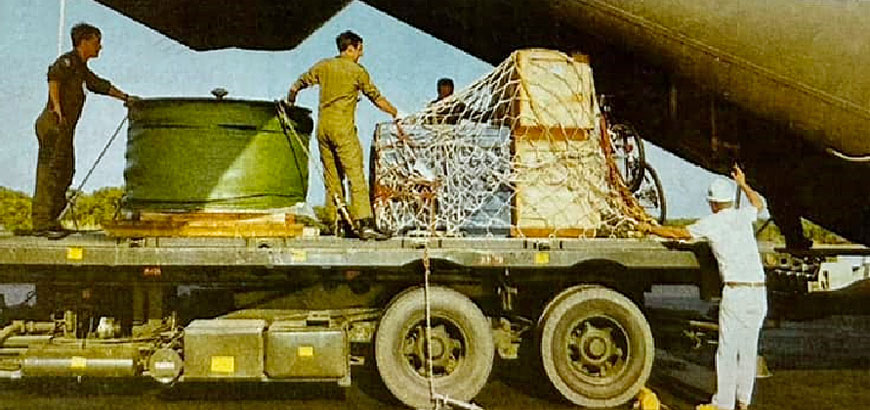
As we chatted, we were joined by Flying Officer Dave Williams, a young co-pilot with 70 Squadron. Dave is two years into his first tour and loving every minute of it. He explained, "The flying out here is great fun. The Americans do things differently from us and that makes for interesting trips. We start flying at eight in the morning and carry the cargo from the mainland under visual flight rules. It is a one-hour flight from Canaveral to Andros, usually up to four hours on the ground and then back and forth depending on how much equipment has to be moved."
Because Gallant Cossack is a costly project, the MAMS team have not stayed at the popular Cocoa Beach Hilton in Florida.
Team leader Flt Lt Simon Hawkins said, "I am staying with my team in a rented apartment. It is saving the tax payer $6,000. I am the only officer, but they are a great bunch and we get on well. As a Supply Officer, I have been in the RAF seven years.
Because Gallant Cossack is a costly project, the MAMS team have not stayed at the popular Cocoa Beach Hilton in Florida.
Team leader Flt Lt Simon Hawkins said, "I am staying with my team in a rented apartment. It is saving the tax payer $6,000. I am the only officer, but they are a great bunch and we get on well. As a Supply Officer, I have been in the RAF seven years.
Loading Navy stores at Canaveral for the flight to Andros in the Bahamas
"One of my happiest memories was learning how to play golf while off-duty in Korat, Northern Thailand. Korat is off the tourist track and is South East Asia's answer to Wigan, but the girls are beautiful and they caddy for you!" added the 27-year-old bachelor.
In the short time I was able to spend with the Mobile Air Movements team, I could not help but be impressed by their enthusiasm and by the sheer hard graft that took place in that sub-tropical corner of the globe. So my thanks to them and the aircrews of 47 and 70 Squadrons who got me there and back safely.
One incident will stay in my memory for quite some time. On the first night of my stay in Florida, the MAMS team invited me to join them for dinner. The venue was superb they assured me and the food very good value for a Yorkshireman a long way from home. Nine of us dined well. The swordfish and lobster could not have been better. The salads were delicious, the Californian wines just a the right temperature. We left in a mellow mood at 11pm.
As we stood outside awaiting taxis, I congratulated my hosts on their choice of restaurant. How much nicer than a fast food hamburger joint! Even as I spoke, a smart white van drove up to the main entrance and two men, in what appeared to be white NBC suits, jumped out of the cab. We watched, fascinated, as the men took back-pack cylinders and long spray guns into the Jolly Lobster Pot (not it's real name). Only then did we spot the sign on the side of the van; it read, "Bugs Killer Inc. National Pest Eliminators for Hotels, Homes and Restaurants."
In the short time I was able to spend with the Mobile Air Movements team, I could not help but be impressed by their enthusiasm and by the sheer hard graft that took place in that sub-tropical corner of the globe. So my thanks to them and the aircrews of 47 and 70 Squadrons who got me there and back safely.
One incident will stay in my memory for quite some time. On the first night of my stay in Florida, the MAMS team invited me to join them for dinner. The venue was superb they assured me and the food very good value for a Yorkshireman a long way from home. Nine of us dined well. The swordfish and lobster could not have been better. The salads were delicious, the Californian wines just a the right temperature. We left in a mellow mood at 11pm.
As we stood outside awaiting taxis, I congratulated my hosts on their choice of restaurant. How much nicer than a fast food hamburger joint! Even as I spoke, a smart white van drove up to the main entrance and two men, in what appeared to be white NBC suits, jumped out of the cab. We watched, fascinated, as the men took back-pack cylinders and long spray guns into the Jolly Lobster Pot (not it's real name). Only then did we spot the sign on the side of the van; it read, "Bugs Killer Inc. National Pest Eliminators for Hotels, Homes and Restaurants."
This Newsletter is Dedicated
to the Memories of:
Harry Grace (RCAF)
Pete "Whisper" Mason (RNZAF)
to the Memories of:
Harry Grace (RCAF)
Pete "Whisper" Mason (RNZAF)
Tony Gale
ukmamsoba@gmail.com
ukmamsoba@gmail.com
